Scottish Shelf Model. Part 5: Wider Loch Linnhe System Sub-Domain
Part 5 of the hydrodynamic model developed for Scottish waters.
3 Hydrodynamic Model Development
3.1 Introduction
This section of the report describes the setting up of the WLLS model mesh, bathymetry and the calibration of the flow model. Model documentation and lessons learnt during this process have been captured in Volume 2 of this report.
3.2 WLLS flow model setup
3.2.1 Model mesh
The model mesh developed for the WLLS model has been created using the SMS mesh generator. The horizontal coordinate system used has been latitude and longitude with a vertical datum of mean sea level ( MSL). Ten vertical layers have been employed within the model simulations, these were initially equally spaced sigma layers but were later set to be mixed with equal layers in depths less than 13 metres and variable for deeper depths. The variable depths had two layers at the surface which are 1m thick, and two layers at the bottom each being 2.5m thick. The remaining 6 layers are equally spaced. The reason for this setup was to be able to resolve better the freshwater outflow in the upper Loch Linnhe.
The SMS Mesh generator requires coastline and boundary data to define the extent of the active and inactive mesh. Additional information is provided regarding the resolution required in user-specified domains. The resolution is based upon modelling experience, bathymetry gradient/resolution, geographical features and requirements for the study. Although the mesh generator is able to create meshes with triangular or quadrilateral elements, FVCOM requires only triangular elements.
Mesh generation can be an iterative process in order to get a mesh that varies smoothly, with triangles that do not have angles that are too acute and resolution that does not require an overly small model timestep. SMS has a number of features to allow for a smooth resolution change throughout the model domain so that adjacent element volumes do not differ by more than a factor of 0.5. Additionally the minimum interior angle was set as 30 degrees, maximum interior angle set as 130 degrees and the maximum number of connecting elements was set as 8. These values were obtained from the FVCOM manual. It had been found previously that the volume factor and the number of connecting nodes did effect the model stability. Figure 3-1a-c show the mesh at different zoom levels.
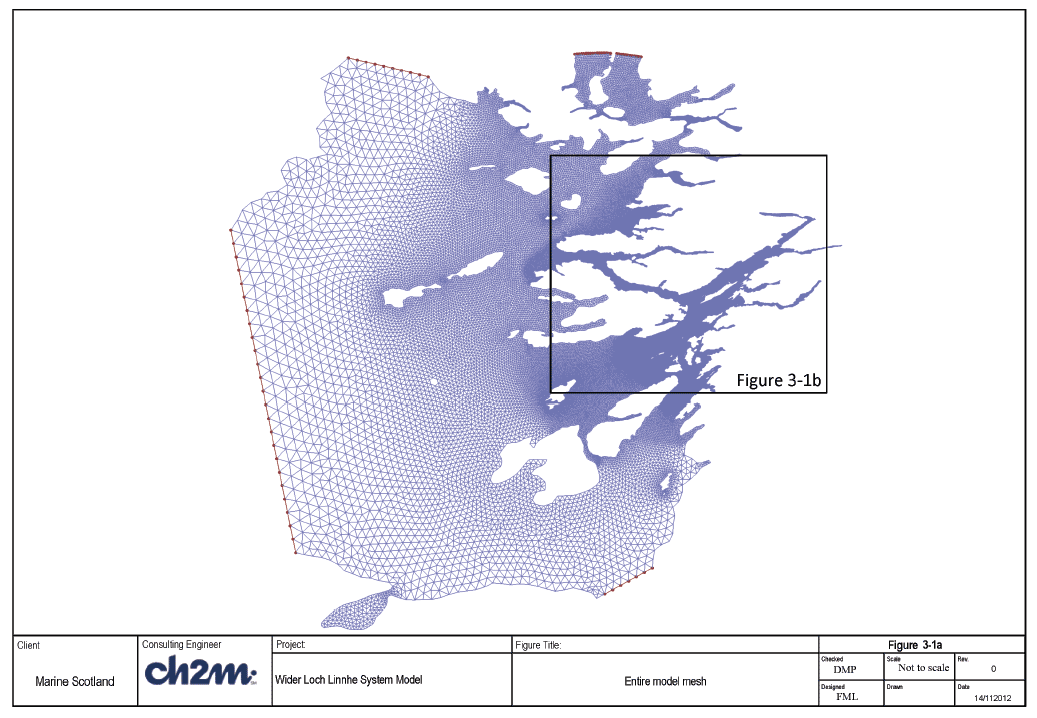
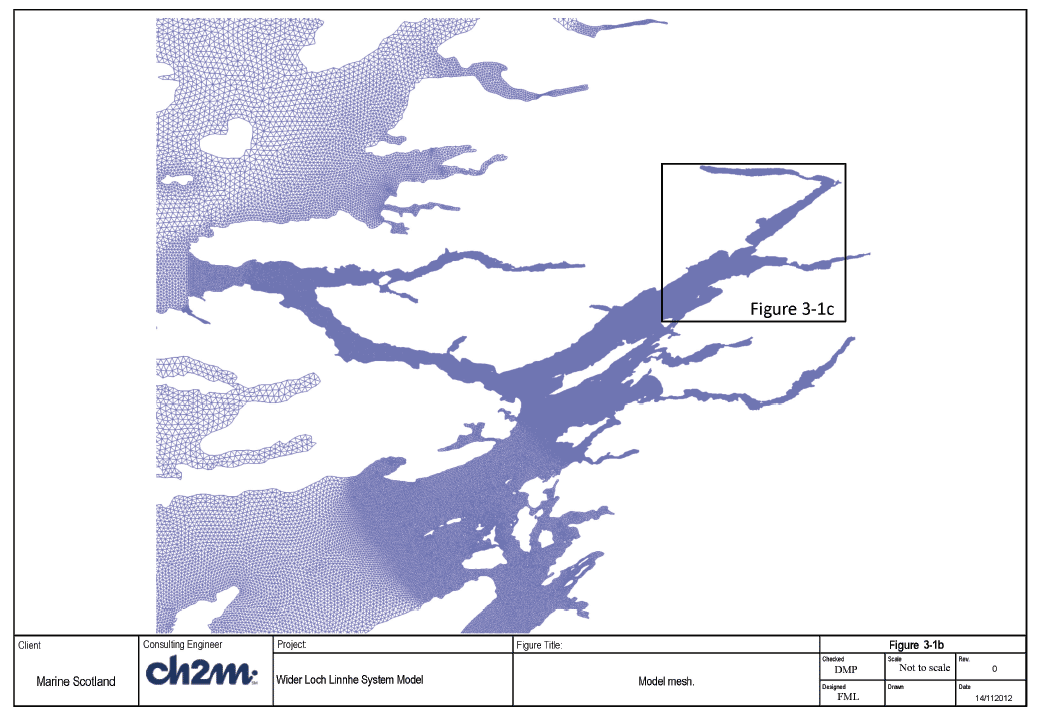
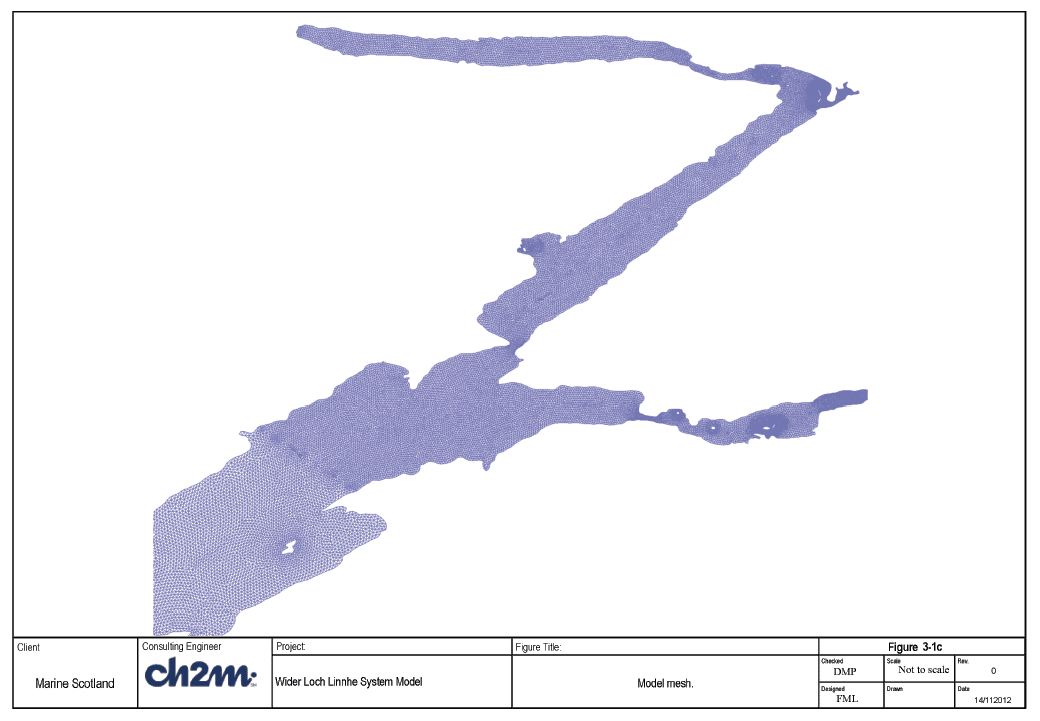
3.2.2 Model bathymetry
The WLLS model mesh was created using the SMS mesh generator. The area of the mesh is contained within the Atlantic Margin Model ( AMM - developed by NOC-L) from which boundary conditions have been obtained.
The bathymetry used for the WLLS model was derived from the same sources as the other case study models, namely:
- EMODNET (coarser and generally offshore),
- higher resolution survey bathymetry (data and other higher resolution datasets from ICES and Marine Scotland) and
- digitised Admiralty Chart data where no other data was available.
The coastline was derived from Ordnance survey coastline data.
This bathymetry was combined to a common datum of MSL and interpolated onto the model mesh within the SMS mesh generator. Figures 3-2a-c shows the extent of the model domain with various zoomed in views showing detail in Loch Sunart, Mull Sound and Loch Linnhe. The open boundaries are highlighted in black. The contours on these images are of the model bathymetry which is relative to MSL.
3.2.3 Boundary data
The WLLS model utilises the FVCOM TYPE 3 nesting boundaries, the location of which can be seen in Figures 3-2 a-c. The boundary data are derived from the AMM model results supplied by NOC-L. TYPE 3 nesting boundaries supply the model with water level, current speed components, temperature and salinity at the nodes/element centres of all of the elements attached to the model boundaries. In addition a weighting is also applied so that a combination of the boundary conditions and the values within the model domain can be determined and applied at the model boundaries. The weighting at the element centres was set as 0.5, whereas the weighting on the nodes along the boundary were set as 0.75, and the nodes inside the model domain set as 0.25.
Two periods for the model calibration and validation were chosen based upon available data (current, temperature and salinity measurements) for comparisons along with data used as forcing for the model ( AMM model availability, met forcing, local wind conditions, river flows from CEH). These were May and October 2011.
The WLLS model is run initially with constant temperature and salinity for a short warm-up period, this outputs a hotstart file which contains information about water levels, current speed and temperature/salinity. To reduce the warm-up period for the temperature and salinity, a Matlab script has been used which writes AMM or Scottish Shelf model temperature and salinity results to the hotstart file (over-writing the constant values in the hotstart file). This allows the follow-on WLLS model hot start conditions to match those applied at the boundary and to have suitable temperature/salinity within the model domain. The external timestep used in the simulations was 0.3 seconds, with ISPLIT set as 5 (ratio of internal timestep to external timestep). Many tests were undertaken to reduce the run times, but due to the high velocities in the side loch sills within Loch Linnhe, this was the largest timestep possible even though some coarsening of the mesh in these areas was also included in the mesh.
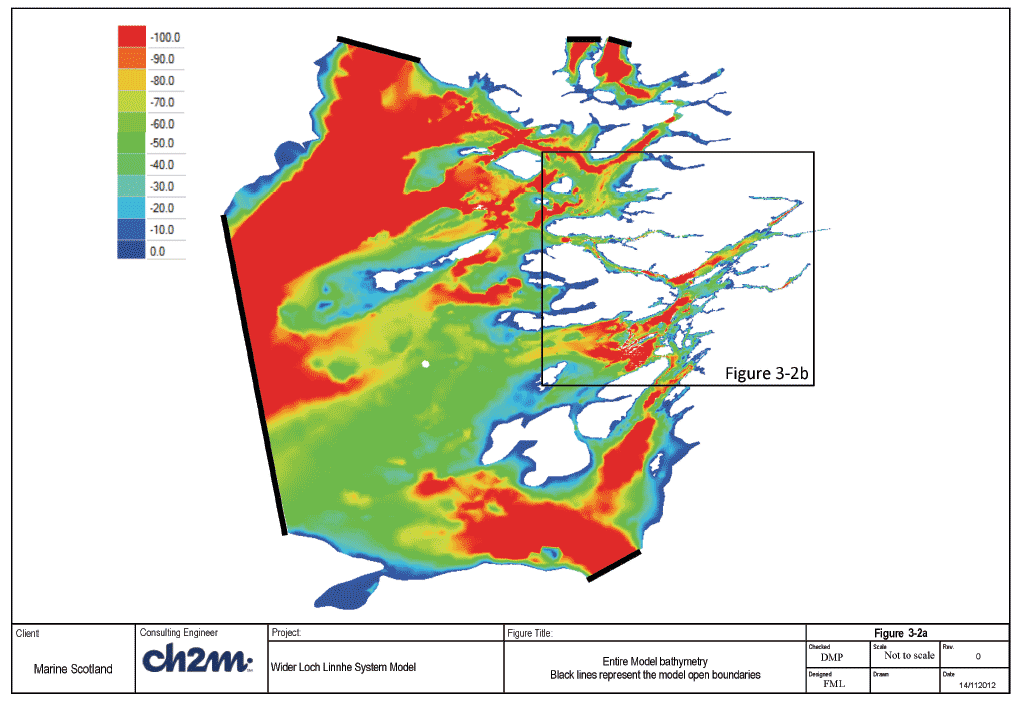
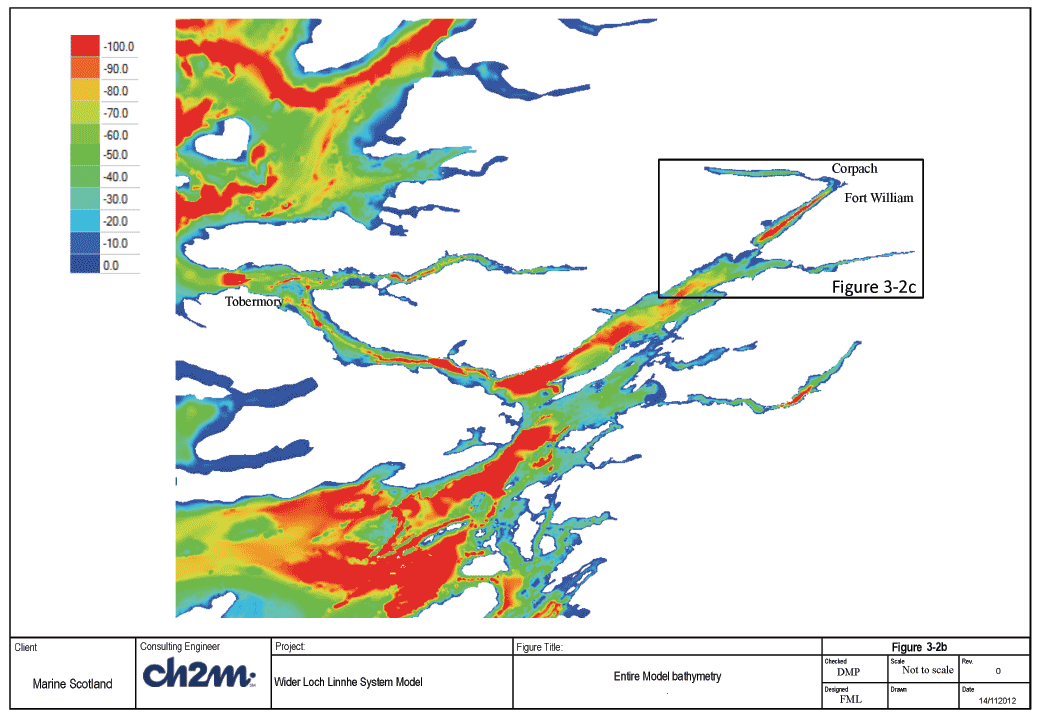
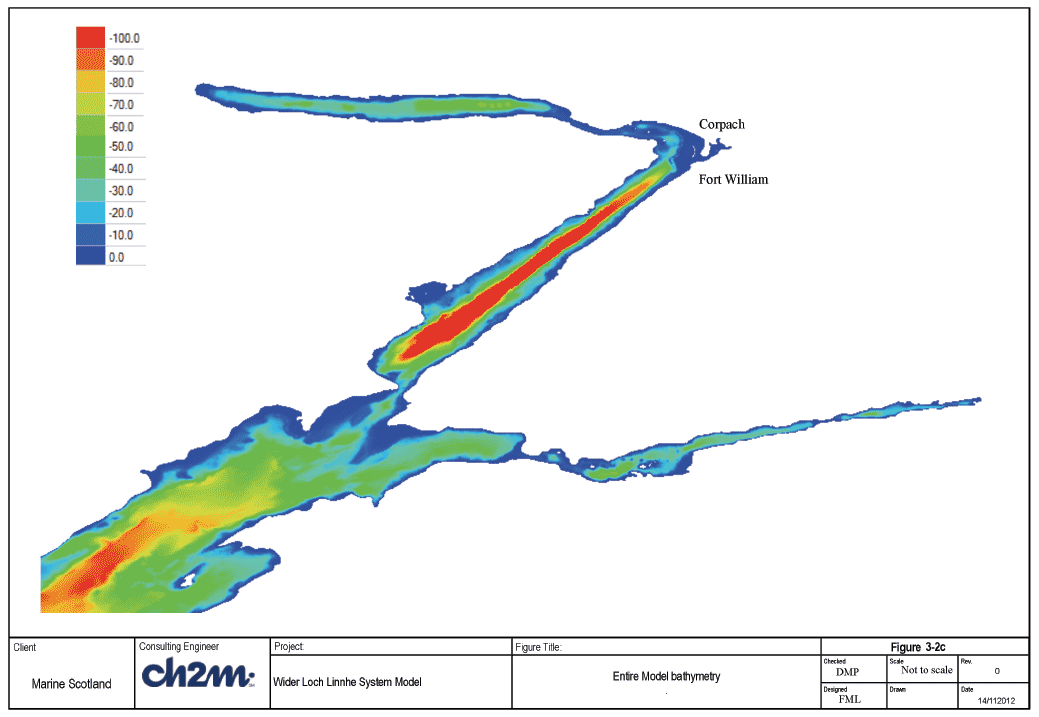
3.2.4 Meteorological forcing data
There are two option when including heat input into the FVCOM model; either the heat inputs are provided by way of netcdf files (from data provided by the Met Office), or FVCOM calculates it internally. NOC-L found that the Scottish Shelf model was heating up too much with the former approach over a 4-month simulation. Furthermore, they found that this overheating problem was solved by allowing FVCOM to calculate the heat inputs internally. The reason for the overheating problem is due to the difference in sea surface temperature used in the Met Office model and the AMM model used for deriving initial conditions.
It is therefore advantageous to follow the NOC-L approach and have the heating calculated within the model so this is the method employed for this case study. The AMM model outputs for 2011 contained only air temperature, sea level pressure, total precipitation and the U and V wind components. The relative humidity and short wave and longwave downward solar radiation were taken from the ECMWF interim data set. It is important to note that the radiation terms from the ECMWF are given as an accumulated total which is reset every 12 hours at midnight and midday. These datasets were processed and a Matlab tool produced which provided the necessary meteorological file for FVCOM.
There were some issues with the meteorological forcing data with rain falling on dry elements, some negative evaporation (and precipitation) as well as cooling of elements that were disconnected from the main water body (at a few places along the coastline). Additionally the Met data grid did not always overlap fully the WLLS model. In order to remove issues associated with these problems, the met data was post-processed to make the values zero in these locations. It was felt that this would not have a significant impact upon the overall model results.
3.2.5 Initial conditions
To avoid long warm-up periods to allow temperature and salinity to reach dynamic equilibrium the shelf model climatology results were used. The AMM results were considered but due to the low resolution (12km) compared to Loch Linnhe it was not used. First the hydrodynamic model is run from cold with constant temperature and salinity. The warmed up water level sand currents are saved in a restart file. This restart file is processed using a MATLAB scripts that interpolates the temperature and salinity from the Scottish Shelf model climatology results on to the WLLS mesh and writes this into the restart file, replacing the constant values.
3.2.6 Local wind condition derivation
It has been observed that the complex hydrodynamics within Loch Linnhe can be affected by the local wind conditions and therefore some consideration of this was included in the modelling. This section briefly explains what has been done to adjust the relatively coarse (compared with Loch Linnhe dimensions) met forcing wind data described in the previous section to account for the effect that the local topography has upon the wind speeds over Loch Linnhe. For a more detailed explanation of the process, see the Technical Note in Appendix A.
The approach used was to obtain wind speed/direction from a number of sites in and around WLLS and correlate for different speeds and directions against a reference site away from the complex topography. This allowed the prediction of wind speeds within Loch Linnhe given wind conditions outside. The criteria for choosing suitable wind stations were: a) data availability, and b) a good spread within the estuary as well as a point outside.
Data for 2011-2012 were available from the following sources:
- MS Data: Duart, Fort William, Cuil Bay and Kingair Loch
- SAMS Data: Oban (Dunstaffnage data were available only until 2010)
Duart and Oban were the two possible reference stations towards the mouth of Loch Linnhe. The other stations are inside Loch Linnhe, and were used for the correlation. The common data periods for 2011-2012 were July-December 2011 and April-October 2012.
After analysis of the data, Duart at the mouth of Loch Linnhe was chosen to be the reference station, whilst Cuil Bay and Fort William were chosen to describe the variation of wind speed and direction relative to Duart; these were located midway and at the head of the Loch respectively. The other location (Kingair Loch) was not used after analysis of the data suggested that it is not entirely suitable due to local topographic features and localised features in the wind conditions. It was felt therefore that accounting for the acceleration of wind blowing up the loch from the sea (as shown in the data) and vice-versa would be our main focus as this may have an effect of holding up the freshwater in the Upper Loch Linnhe. This approach takes account of the increase/decrease in wind speeds along the length of the Loch for different directional sectors. Using the Met Office wind speeds at Duart, these are scaled and interpolated onto the model mesh within Loch Linnhe.
The three locations used were corrected for altitude, then ratios of wind speed relative to Duart calculated for Fort William and Cuil Bay for 22.5 degree sectors. Likewise the direction deviation in wind direction compared with Duart are calculated at these two locations for the same directional sectors. The values obtained for the two sites are shown in Table 3-1. It can be seen that for winds blowing up the Loch from the sea, wind speeds at Cuil Bay are 1.2 times greater, and at Fort William are 1.6 times greater than the wind speeds at Duart. For wind blowing down the Loch from the land, the wind speed ratios at Fort William and Cuil Bay relative to Duart (1.0) are 0.7 and 0.8 respectively. Following on from the calculation of the wind speed scaling and direction shifts, the speeds/directions at Duart within the met data are interpolated linearly along the length of the estuary replacing the wind speeds within the original met file that had been created previously.
Table 3‑1 wind speed ratios and wind direction shifts for Cuil Bay and Fort William relative to Duart
| Loch Linnhe Station | Cuil Bay | ||||||||||||||||
|---|---|---|---|---|---|---|---|---|---|---|---|---|---|---|---|---|---|
| Look up Table | |||||||||||||||||
| From Direction (dgr) | 0.0 | 11.3 | 33.8 | 56.3 | 78.8 | 101.3 | 123.8 | 146.3 | 168.8 | 191.3 | 213.8 | 236.3 | 258.8 | 281.3 | 303.8 | 326.3 | 348.8 |
| To Direction (dgr) | 11.3 | 33.8 | 56.3 | 78.8 | 101.3 | 123.8 | 146.3 | 168.8 | 191.3 | 213.8 | 236.3 | 258.8 | 281.3 | 303.8 | 326.3 | 348.8 | 360.0 |
| Wind Speed ratio | 1.0 | 1.0 | 0.9 | 0.8 | 0.9 | 1.0 | 1.1 | 1.2 | 1.3 | 1.3 | 1.2 | 1.1 | 1.0 | 0.9 | 0.8 | 0.9 | 1.0 |
| Wind Direction Difference | 3.5 | 3.9 | -4.6 | -12.7 | 17.7 | -1.1 | 21.5 | 12.2 | -16.6 | -33.0 | -33.8 | -27.3 | -11.4 | 26.6 | 20.3 | 16.1 | 3.5 |
| Loch Linnhe Station | Fort William | ||||||||||||||||
| Look up Table | |||||||||||||||||
| From Direction (dgr) | 0.0 | 11.3 | 33.8 | 56.3 | 78.8 | 101.3 | 123.8 | 146.3 | 168.8 | 191.3 | 213.8 | 236.3 | 258.8 | 281.3 | 303.8 | 326.3 | 348.8 |
| To Direction (dgr) | 11.3 | 33.8 | 56.3 | 78.8 | 101.3 | 123.8 | 146.3 | 168.8 | 191.3 | 213.8 | 236.3 | 258.8 | 281.3 | 303.8 | 326.3 | 348.8 | 360.0 |
| Wind Speed ratio | 0.9 | 0.8 | 0.7 | 0.7 | 0.6 | 0.9 | 1.0 | 1.1 | 1.3 | 1.6 | 1.6 | 1.6 | 1.3 | 0.9 | 0.9 | 0.9 | 0.9 |
| Wind Direction Difference | -48.8 | -10.1 | -2.4 | -10.2 | -28.7 | -21.0 | -16.2 | 0.9 | 1.2 | -16.6 | -32.7 | -32.6 | -42.0 | -15.6 | -4.5 | -42.9 | -48.8 |
3.3 River input
River data was obtained from CEH and encompassed all of 2011 at 15 minute intervals. This data was processed using a MATLAB tool that determined which mesh node to apply the river flow to. It also moved the location of a river node to the nearest land node if it was connected to two other land nodes in the same element (if connected in this way, then the river flow cannot escape the element and water levels build up artificially too high).
A river namelist file was produced along with a netcdf file for each of the rivers named in it. On further application of the Scottish Shelf model it was found that reading in over 500 river files impacted upon model performance (input/output overhead). Therefore only one namelist and river file were employed for this study, encompassing all of the rivers within the model domain.
The salinity in the river flow was set to 0 psu, and the temperature was initially set to 7 degrees Celsius as this was appropriate for the nearshore temperatures from the AMM model, but was increased to 10 degrees Celsius for the final calibration runs.
The river flow is distributed equally amongst all of the vertical layers. In the upper Loch Linnhe and other side lochs, the Grid2Grid model ( CEH) did not resolve the river sources, however the discharge for tributaries further upstream were included in the furthest points upstream in each of these water bodies. Therefore to include the river discharges in the correct place, the river flow was redistributed according to the catchment area of the upstream tributaries.
3.4 Initial Sensitivity runs
A number of sensitivity runs were carried out during calibration of the WLLS model. These include sensitivity to wind scaling, vertical mixing and the number of layers used. Please note that these sensitivity comparisons are not from the final calibration run, and some changes in the initial conditions were made to these runs.
3.4.1 Wind scaling
The sensitivity of the model results to the scaled wind at a number of locations around Loch Linnhe and Loch Sunart for the May 2011 run is presented in Figure 3-3a. Figure 3-3b shows the scaled wind speed and direction at location A, C and E and the unscaled wind at E as a reference. This shows that when winds are directed up the Loch (winds blowing from SSE to WSW) the wind speed increases up the Loch this is most significant for winds from the SW. The influence of the scaled wind on sea surface temperature and salinity is small, with the RMS difference and bias less than 2% at all stations except A which is where the increase in wind speed is highest and is close to the outflow of River Lochy and River Nevis which have a high combined discharge rate. At station A the temperature and salinity bias is positive showing a 1.9% or 0.2°C and 11% or 1.2psu increase respectively. The channelling of the wind up the Loch in the scaled wind is likely to hold back or alter the flow of the incoming fresh water at Station A causing a slight increase in temperature and salinity at that location. The RMS difference in current flows is up to 10% in Loch Linnhe, little difference is seen in Loch Sunart as the scaled wind is not applied there. The bias in the data in Loch Linnhe and the sound of Mull is however very small. Please note these sensitivity test were not carried out on the final calibration run but during the calibration process.
3.4.2 Vertical mixing
To test the sensitivity of the model results to vertical mixing the vertical mixing coefficient and vertical Prandtl number were reduced by a factor of 10 from the default values used in the three other local models, i.e. from 1E-5 to 1E-6 and from 1.0 to 0.1 respectively. Figure 3-4 shows the model sensitivity for May 2011 at a number of locations around Loch Linnhe and Loch Sunart. The largest impact is seen in salinity at Location A, close to the outflow of River Lochy and River Nevis, here the reduction in vertical mixing lead to an increase in the bias of salinity of around 24% (2.7 psu). At all other locations the bias in salinity is small (<1.5%), as is the bias in temperature (<1.5%) and current speeds (<6.2%).
3.4.3 Vertical layer schematisation
A sensitivity run to the number of vertical layers was carried out. A 12 layer model was set up in an attempt to capture the drop in salinity seen at the data buoy, an extra two layers were added to the surface layers so the top four layers had a thickness of 0.2, 0.4, 0.6 and 0.8m respectively the lower 8 layers remained as they were in the 10 layer model. The comparison with the 10 layer model and the data is shown in Figure 3-5. Increasing the number of layers and reducing the thickness of the upper layers had the opposite effect to what was expected. During periods of low or no river flow the results were similar, however during periods of high river flow the surface salinity increased relative to the 10 layer model. The surface temperature did drop slightly relative to the 10 layer model.
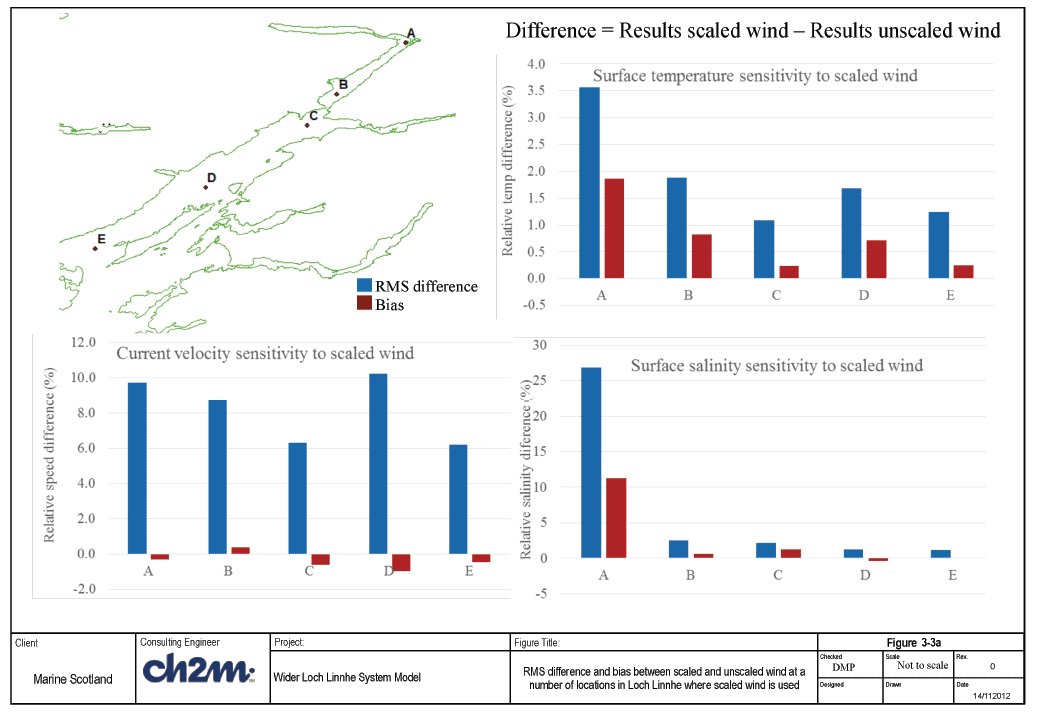
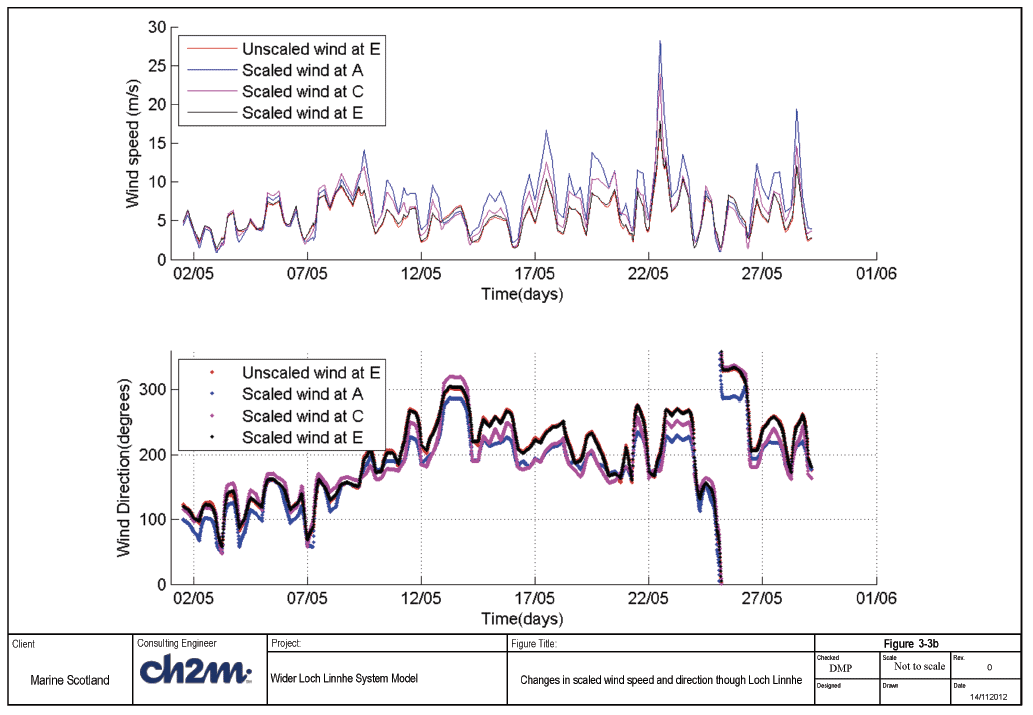
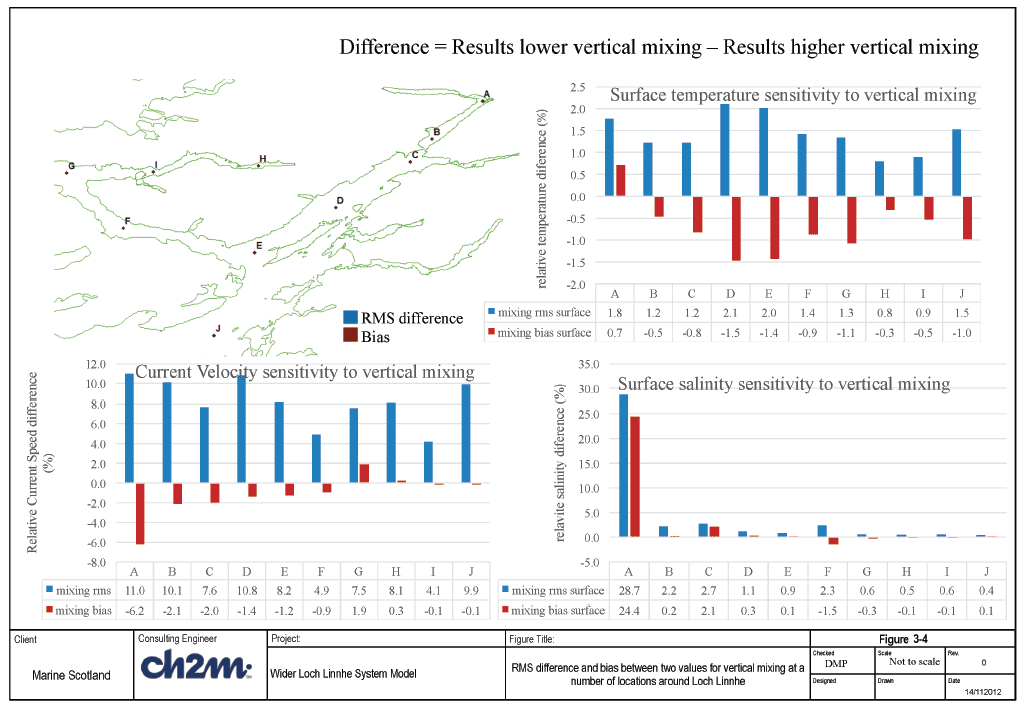
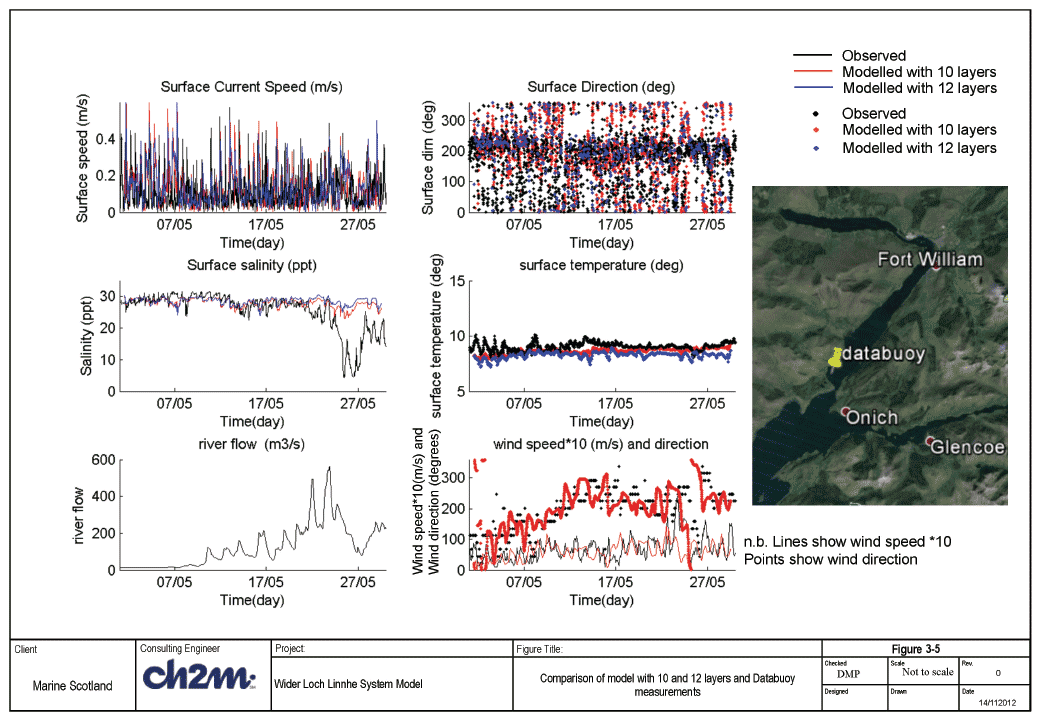
3.5 Flow model calibration
A range of datasets were available with which to calibrate the WLLS hydrodynamic model. Water level data were available for long periods at Tobermory and Corpach, with 6 month records at the southern end of Loch Linnhe and Fort William. Currents, CTD profiles and longer term temperature and salinity measurements were available at a range of locations within Loch Linnhe from a survey undertaken by Marine Scotland in 2011 during the months of May and October, although some instruments covered all of the period between these two months. Additionally MS undertook a short survey to record current speeds and temperature/salinity in June 2013 in the Mull Sound and entrance to Loch Sunart.
The different timeframes at which the various current measurements were available, combined with the periods when we had suitable boundary and meteorological forcing data meant that it was difficult to run the model with all of the met forcing and coincident boundary conditions to that of the available data; boundary conditions were available for 2011, as was the met data and therefore May and October 2011 were used for the calibration and validation periods respectively. Current data obtained during other timeframes were compared with the May 2011 model results following harmonic analysis of both data and model results.
Initially the model was run for the month of May 2011, with river input and full met forcing. The results of which were compared with water levels, currents and temperature/salinity.
Many tests were undertaken with both the initial conditions, the river flow distribution (in the Upper Loch Linnhe ( ULL) tributaries) and the vertical resolution to try and get the salinity to drop during high fluvial flow conditions to match the measurements at the Data buoy in ULL. The best results were obtained with a variable vertical resolution.
To keep runtimes at a sensible limit, 10 layers was found to be appropriate. However as will be seen later, the Data buoy in ULL showed large drops in salinity during high freshwater flow periods. Although a drop in the salinity was seen in the model, but the modelled drop was not as large as measured. It was felt that 10 uniform sigma layers did not provide sufficient near-surface resolution and therefore a variable vertical resolution was employed. For depths less than 13m, 10 vertical, equally spaced sigma layers were used. For depths greater than this, the top two layers had a thickness of 1.0m, and the bottom two layers had a thickness of 2.5m, with the remaining 6 layers split amongst the remaining thickness of water. This allowed greater resolution near to the surface in the deeper water as well as close to the bed. It was felt that the freshwater from the rivers would spread out as thin as possible on the surface of ULL, if the surface layers were too thick then this would not be resolved and the predicted salinity would be too high.
The model parameters applied to the FVCOM WLLS model were as follows:-
Horizontal mixing coefficient = 0.3
Horizontal Prandtl number = 1.0
Vertical mixing coefficient = 1E-6
Vertical Prandtl number = 0.1
Bed roughness = 0.1
The calibration of the model was undertaken for the month of May 2011. Comparisons between the simulated model results and observed water levels can be seen in Figures 3-6a-d for the southern end of Loch Linnhe, Tobermory, Fort William and Corpach. The model simulation included full met forcing, river input and adjusted wind speeds within the Loch. It can be seen that for the majority of the month the predicted water levels are a good match with the observed data. However from the 18/5/2011, it can be seen in Figure 3-6a that there is a vertical shift in the observed water levels. Consultation with MS revealed that the shift was due to the mooring sliding down the steep slope it was deployed on. However around the 24-25 th May 2011 there appears to be a vertical shift in water levels at all of the gauges, especially at Fort William and Corpach. The reason for this shift is unclear.
Without including this period, and only using the first 20 days of the simulation, the RMS errors from three of the locations are:-
Tobermory
RMS error = 0.29m
Bias error = -0.10m
Corpach
RMS error = 0.27m
Bias error = -0.05m
Fort William
RMS error = 0.28m
Bias error = -0.06m
This shows an average RMS error of 0.22m, which given the tidal range of 2-4m, gives an approximate percentage RMS error relative to the tidal ranges of between 7-15% which is within the bounds required for this type of modelling ( i.e. it is within the EA guidelines).
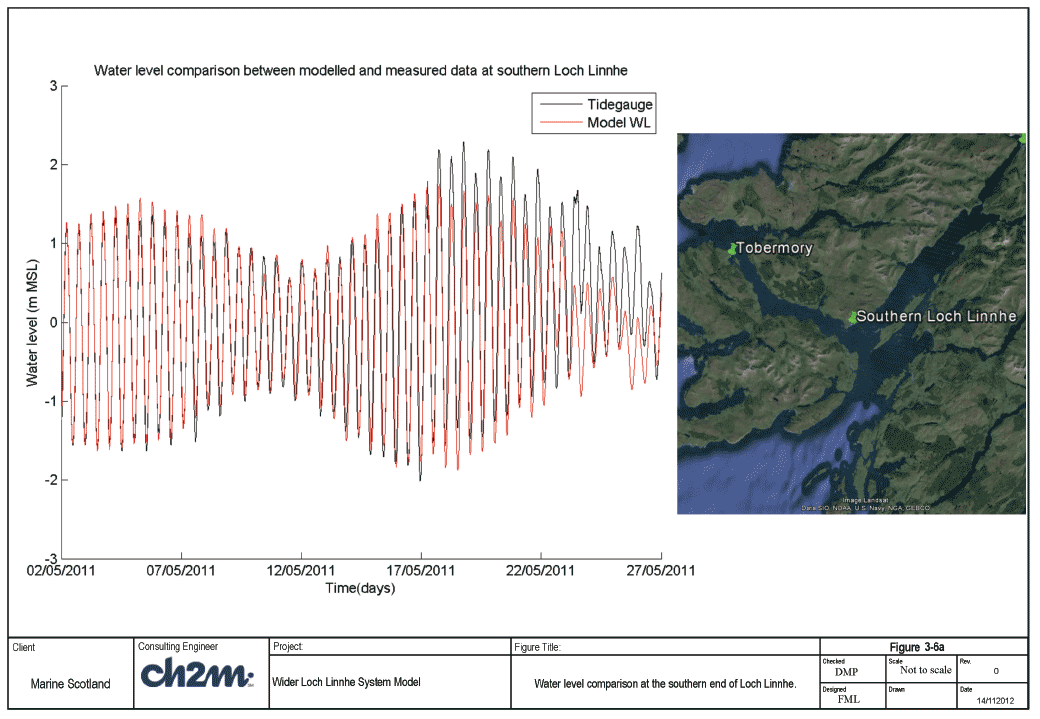
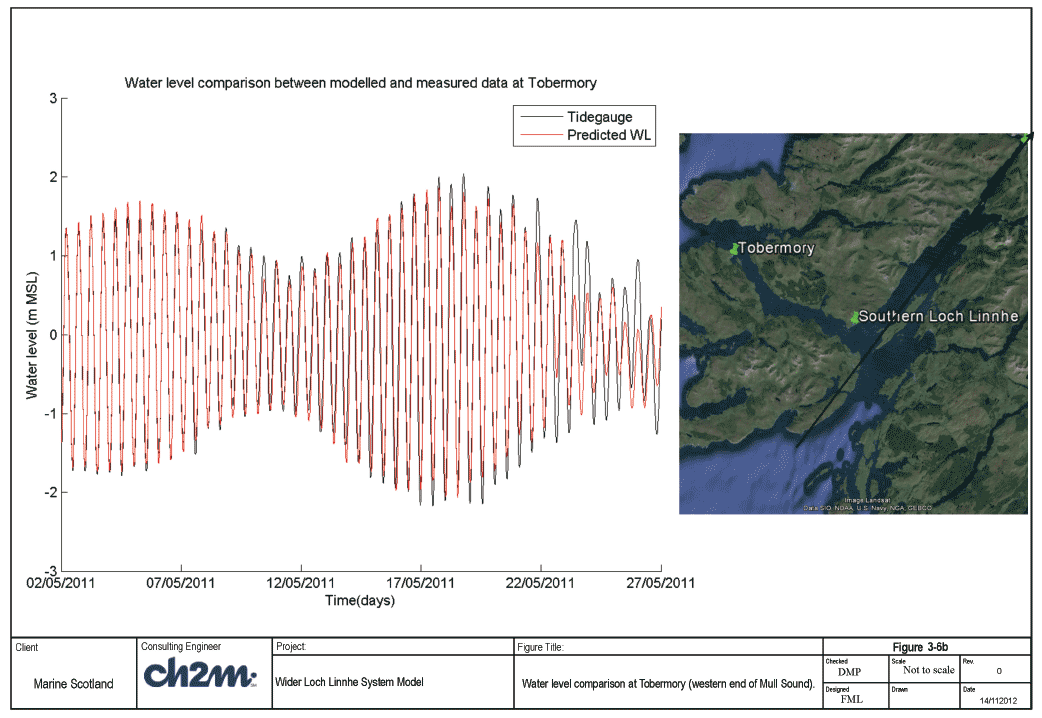
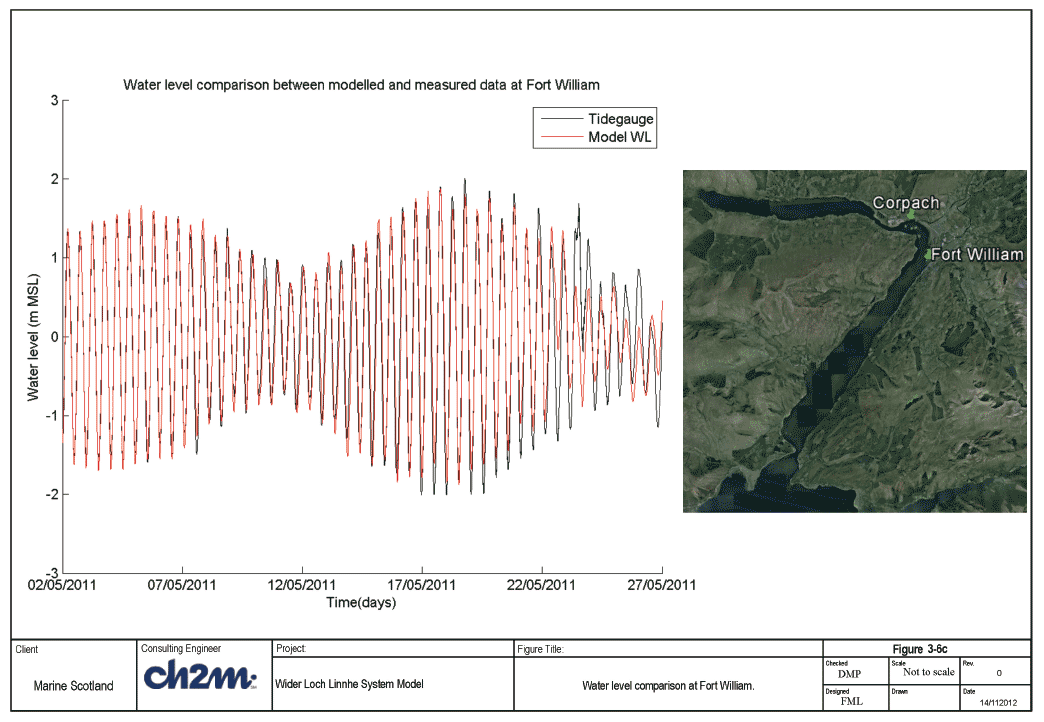
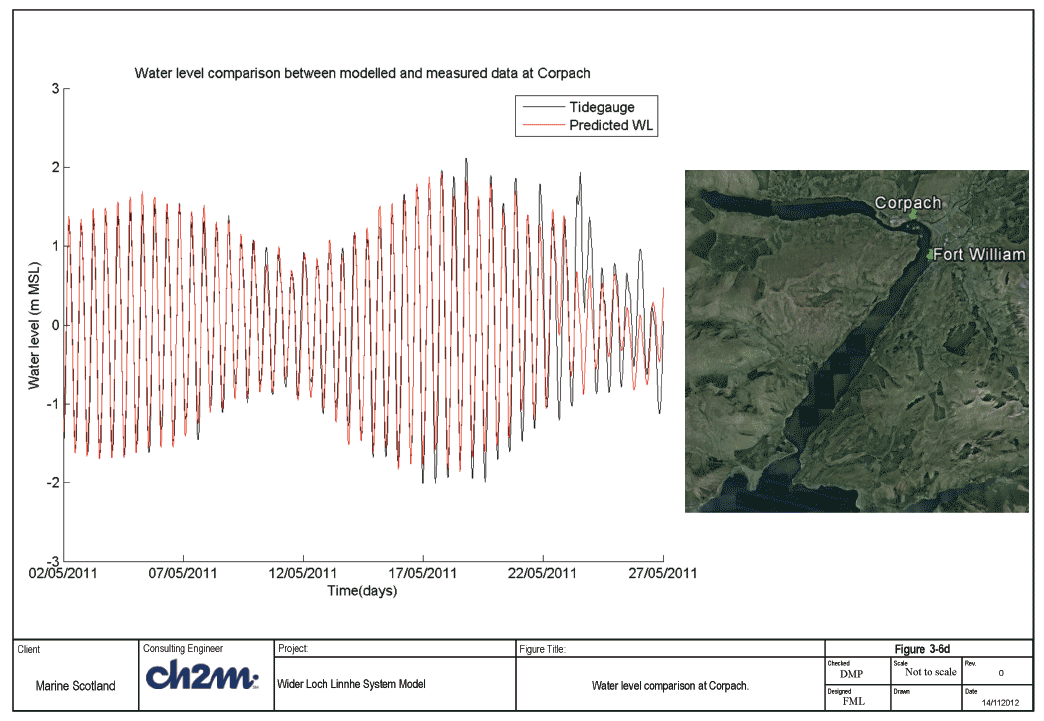
Current measurements available during the month of May 2011 and within Loch Linnhe took the form of RDCP measurements (Figure 3-7) and surface data buoy measurements of current speed/direction, temperature and salinity (Figure 3-8). The comparisons between model current speeds (red) and the observed speeds (black) recorded by the RDCP can be seen in Figure 3-7 for surface (at 5.2m), mid-depth (at 14.8m) and bed (at 26m). The instrument was within an eddy which encompasses the bay in which the RDCP was located. This makes it quite difficult to get an exact match with the timing of the peak currents as it can be quite difficult to reproduce the effect of eddies exactly the same as observed. The data was provided at layers within the water columns. For comparison purposes, Figure 3-7 shows the comparisons at the surface, middle and near bottom of the water column. Although the exact timing of the peak speeds has not been predicted exactly, the general variation in current speed both through time and through the vertical shows a good reproduction of the current magnitudes and the variation of those measured. In general the current directions are also reproduced well at this scale. When examined more closely, the current speeds closest to the bed produced the best comparison with the data.
The data buoy recorded data (currents, temperature and salinity) at the surface of the water column. Figure 3-8 shows the comparisons with near-surface currents speed, salinity and temperature at the data buoy, along with the river flow and wind speeds/directions applied to the model compared with measurements at Fort William. The current speed peaks show a reasonable comparison with the data although when examined in more detail the peaks do not always match up exactly. The location of the data buoy is also within an eddy at the southern end of ULL which adds additional difficulty in getting a closer match with peak speeds and direction. The model is very sensitive to salinity conditions within the model which can affect the surface current speeds greatly. The comparison of salinity measurements with the model predictions shows a good agreement for most of the time until river flows into ULL starts to go above 200 cumecs for about 7 days at which point the salinity in the surface of the model does not drop as much as has been measured. It is hypothesised that the fresher water will be a thin buoyant layer that is not adequately resolved with the 1.0m thick top layer in the model (although this was the aim in reducing the surface layer thickness). However the temperature predicted by the model is in good agreement with the model throughout the period of the simulation, this may be partly due to the convective nature of heat in the water as well as input from radiation.
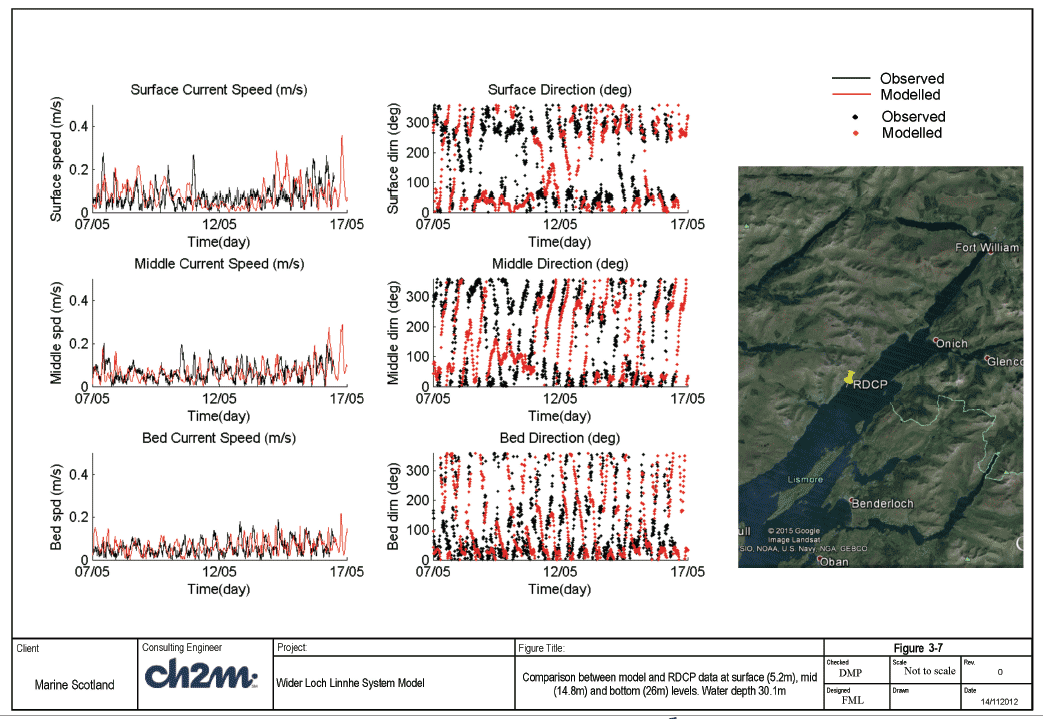
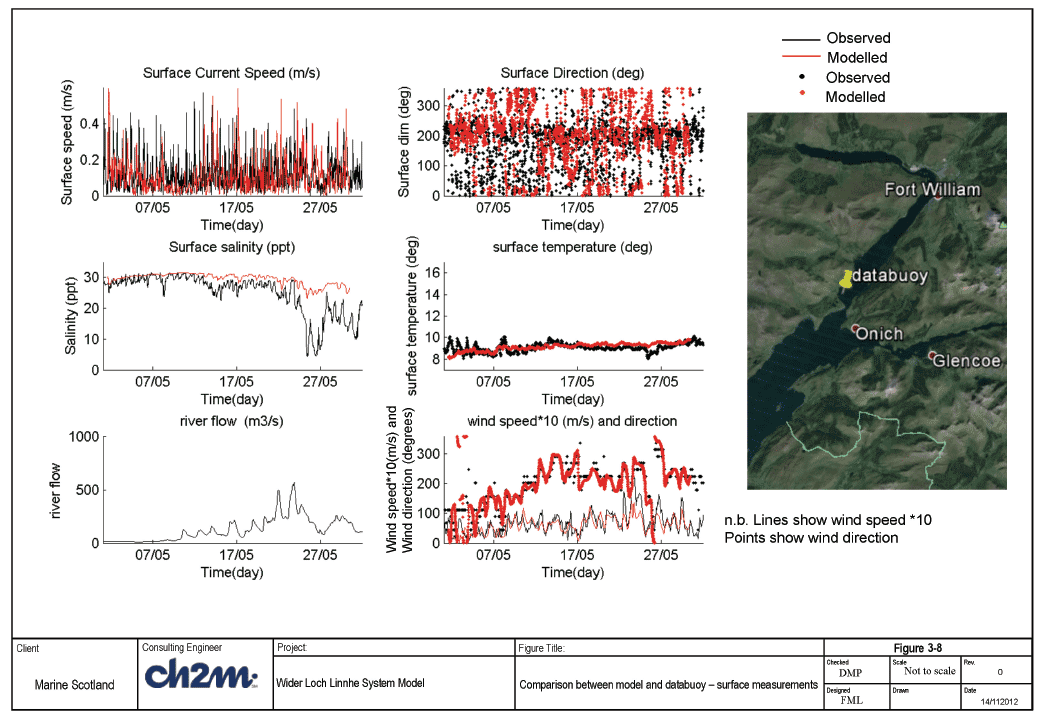
Further salinity and temperature measurements were made in the form of vertical profiles made at a range of locations by way of dropping a CTD probe through the water column and then bringing it back up to the surface again. Figures 3-9a-j show the vertical profile comparisons (red - model, black - observed) for salinity and temperature along with the position in the tidal cycle and the location within Loch Linnhe. The comparison between the observed and modelled temperature and salinity is good. Near surface salinities show a reduction close to the surface which is picked up by the model. There are instances however where the observed temperature close to the surface is higher than in deeper depths showing a distinct thermocline at about 20m depth. This is not picked up by the model to the same extent although this feature is still evident. However a river water temperature of 7 degrees Celsius has been assumed, this may have an effect on the near surface temperature if this differs significantly from the actual value (which is unknown).
To conclude the model has been calibrated against available data within Loch Linnhe, comprising water levels, current speeds, temperature and salinity. It has been shown that in general the model is able to reproduce the measurements within a reasonable magnitude. 5-11% for tidal levels (compared with tidal range), current speeds within 0.1m/s and temperature, salinity generally within 1 degrees and 1ppt, although the salinity is not reproduced well at the surface during high fluvial flow; it was initially thought that this is partly due to the resolution not being fine enough in the vertical, however the 12 layer model sensitivity test proved to have the opposite effect, increasing salinity relative to the 10 layer model. It is not clear what caused this increase in salinity.
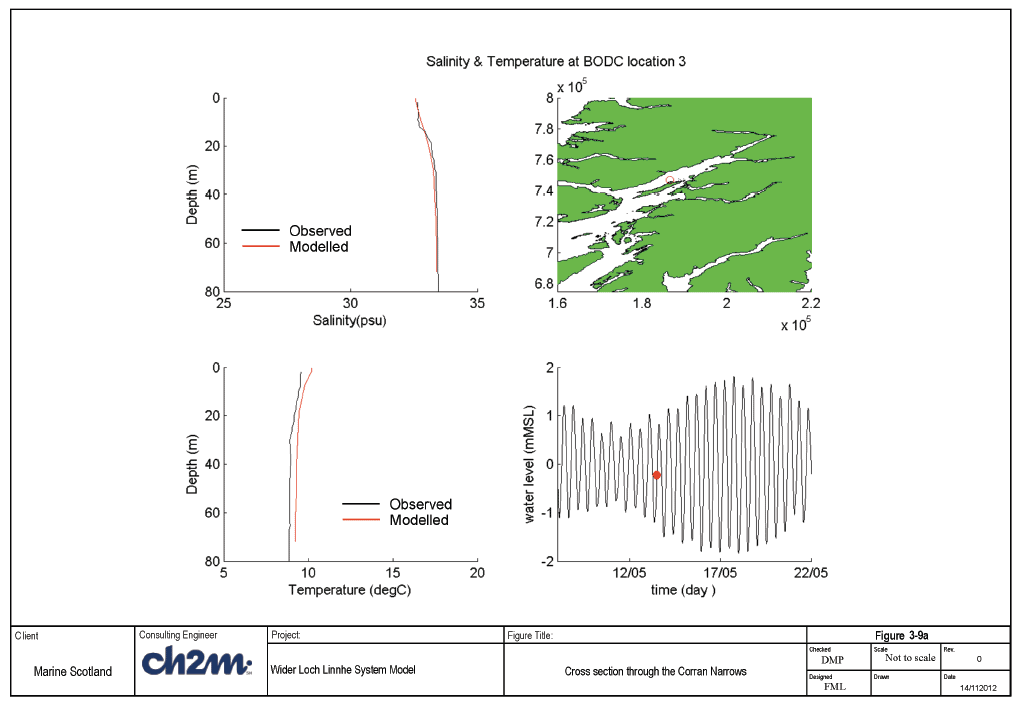
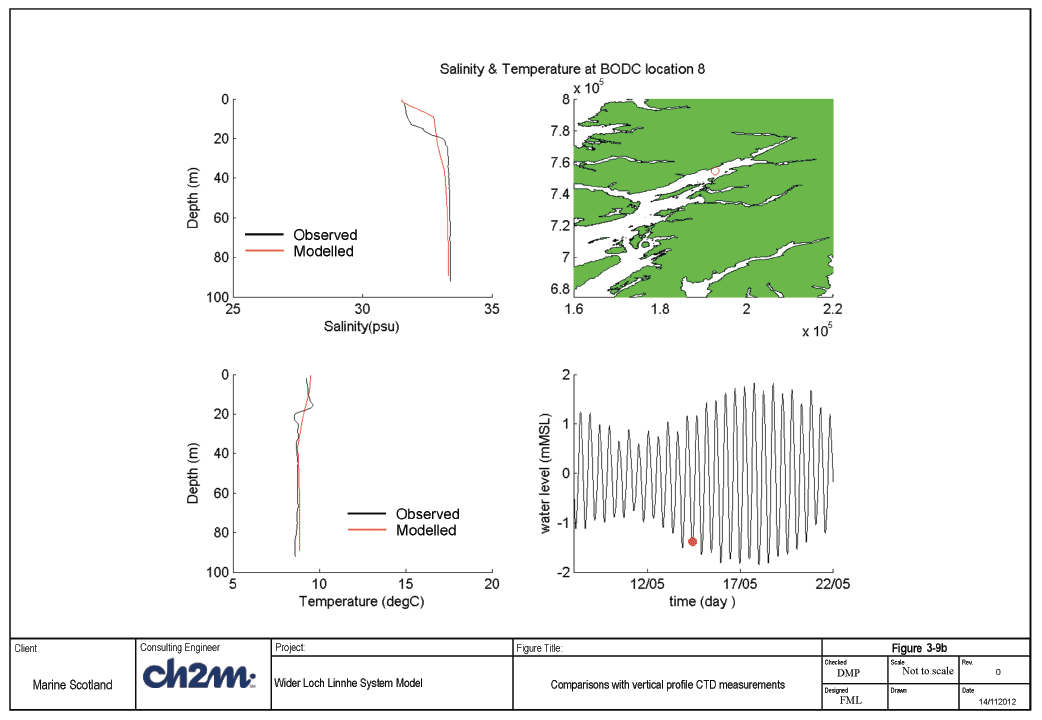
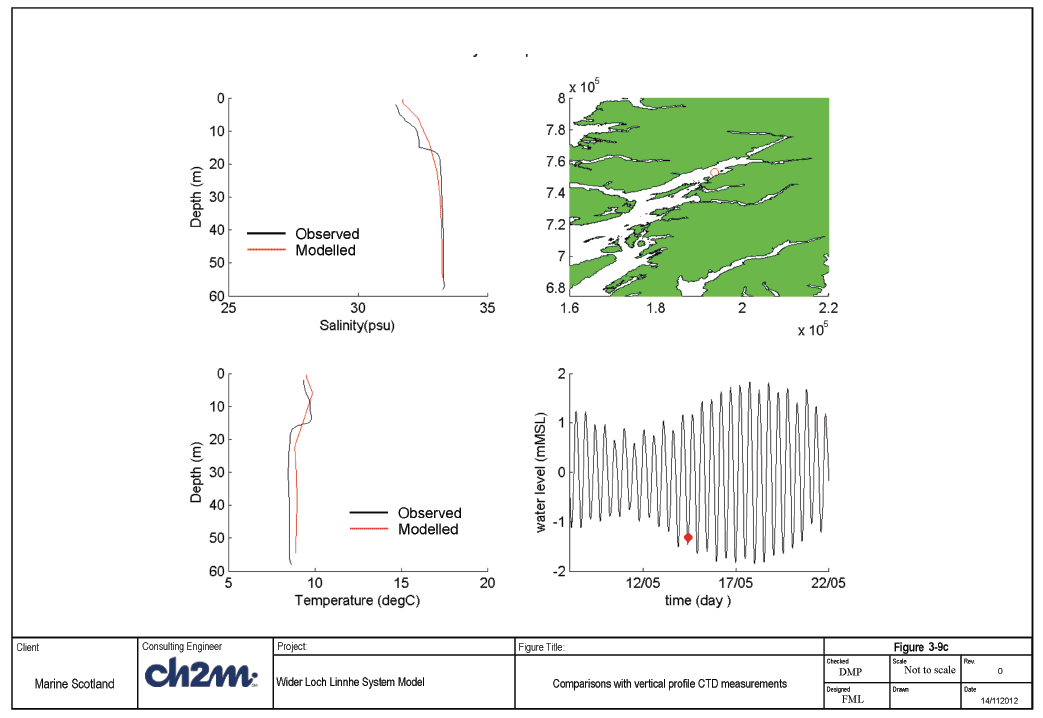
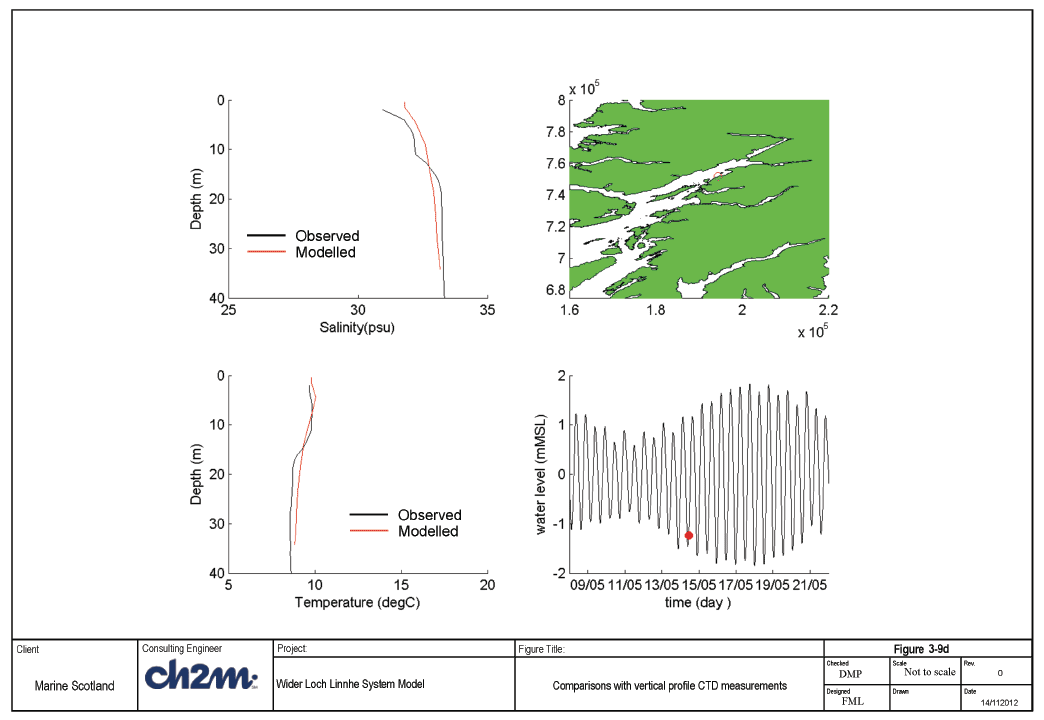
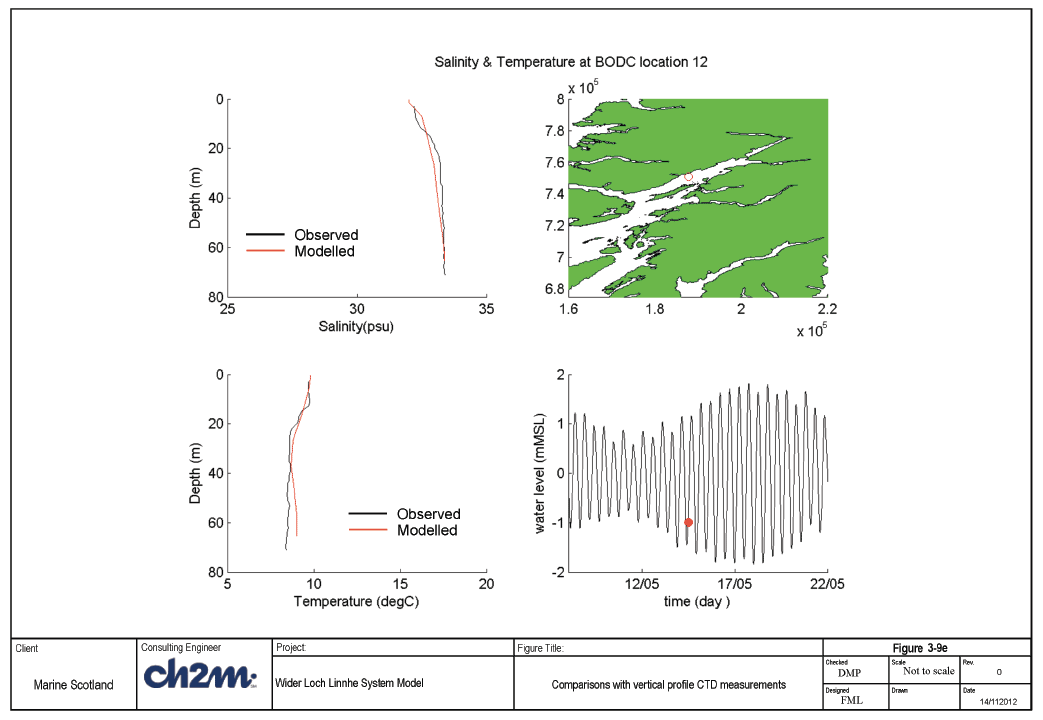
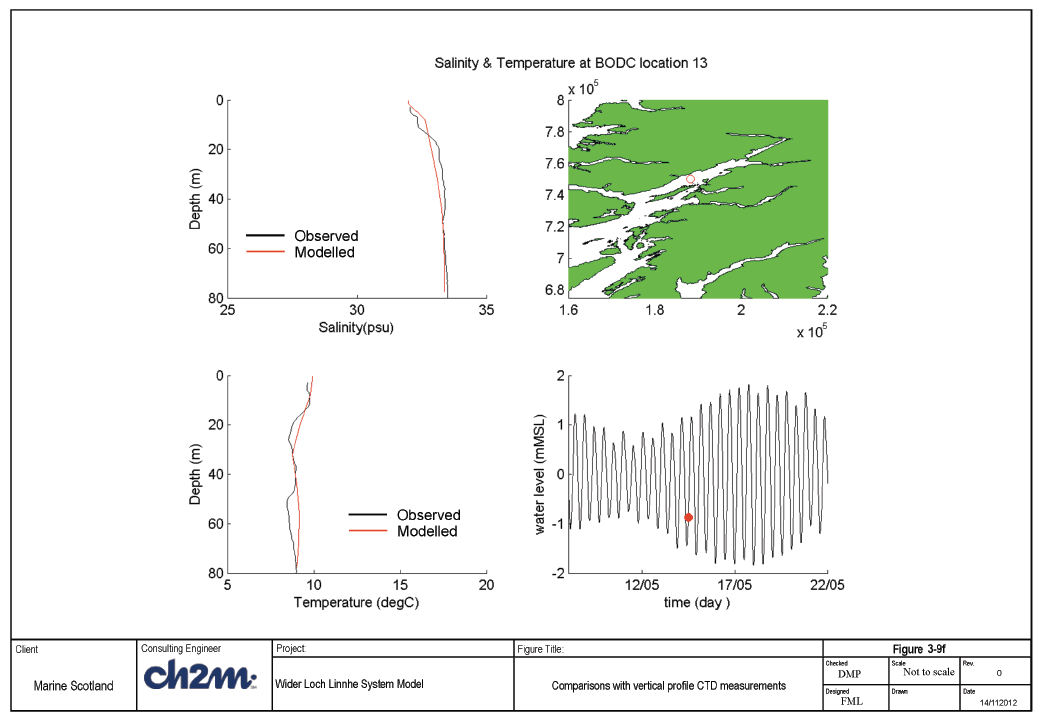
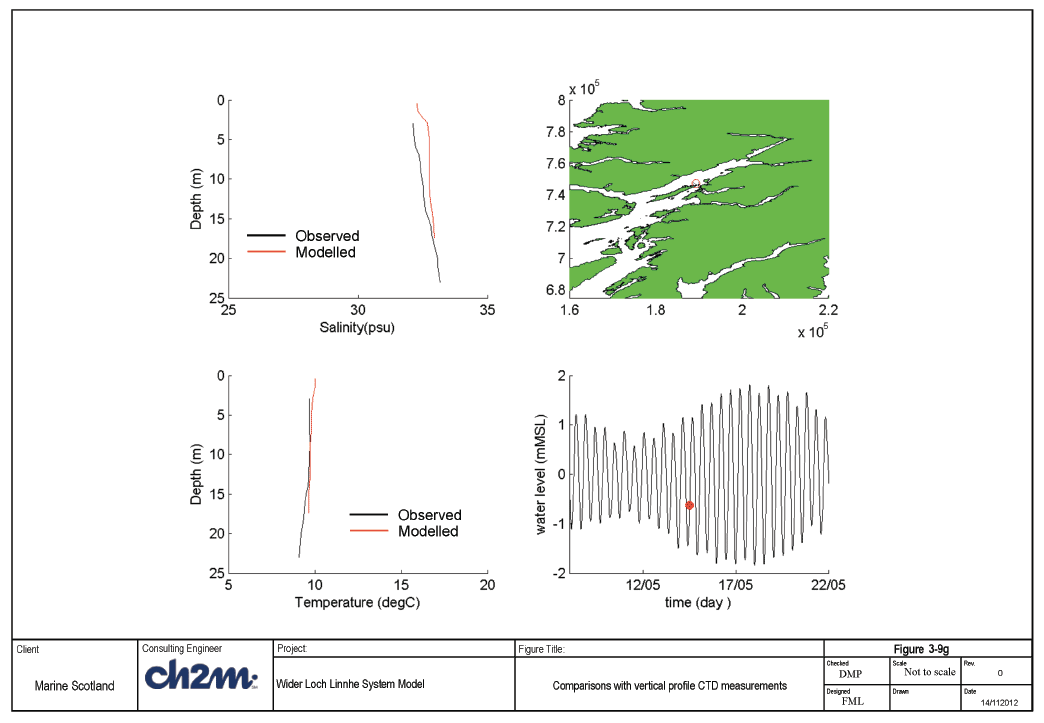
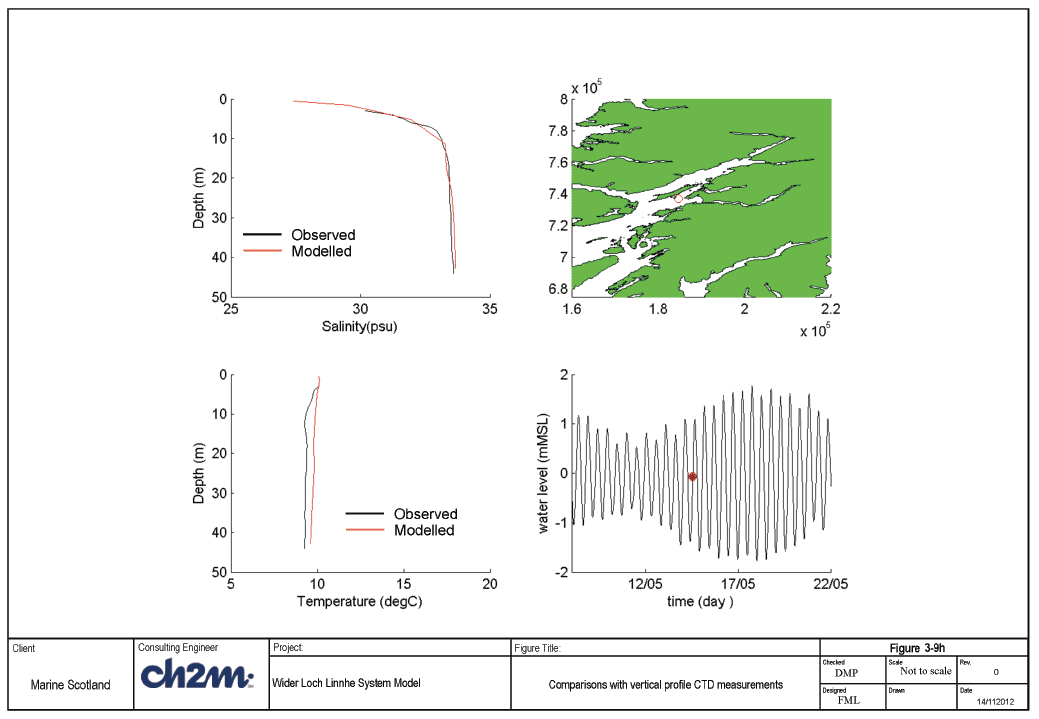
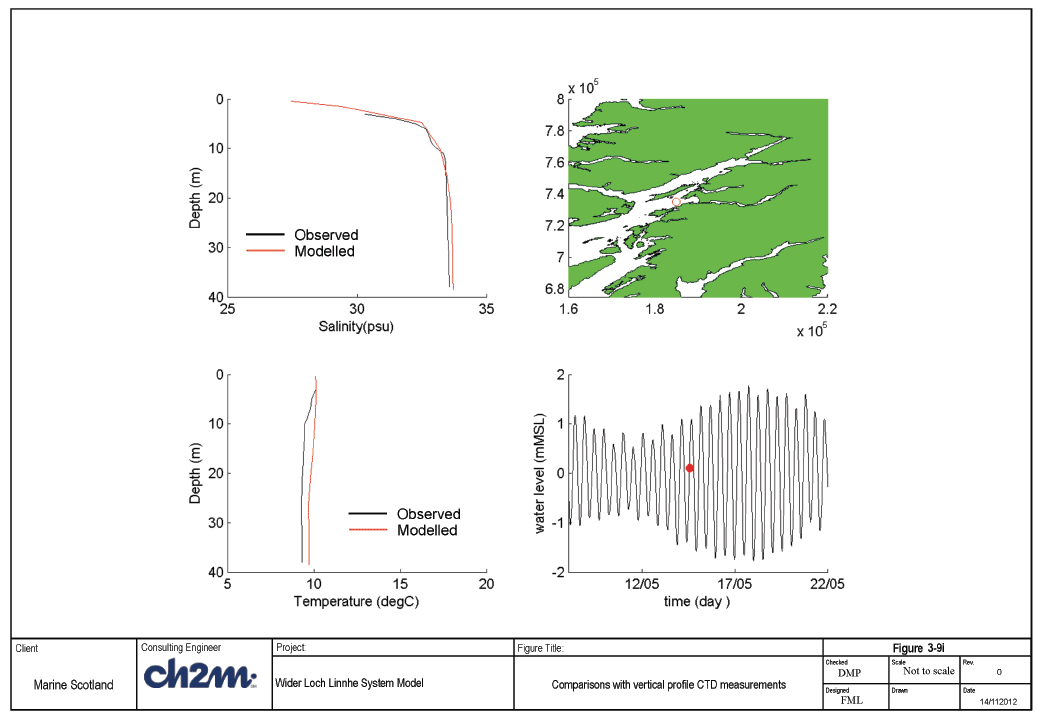
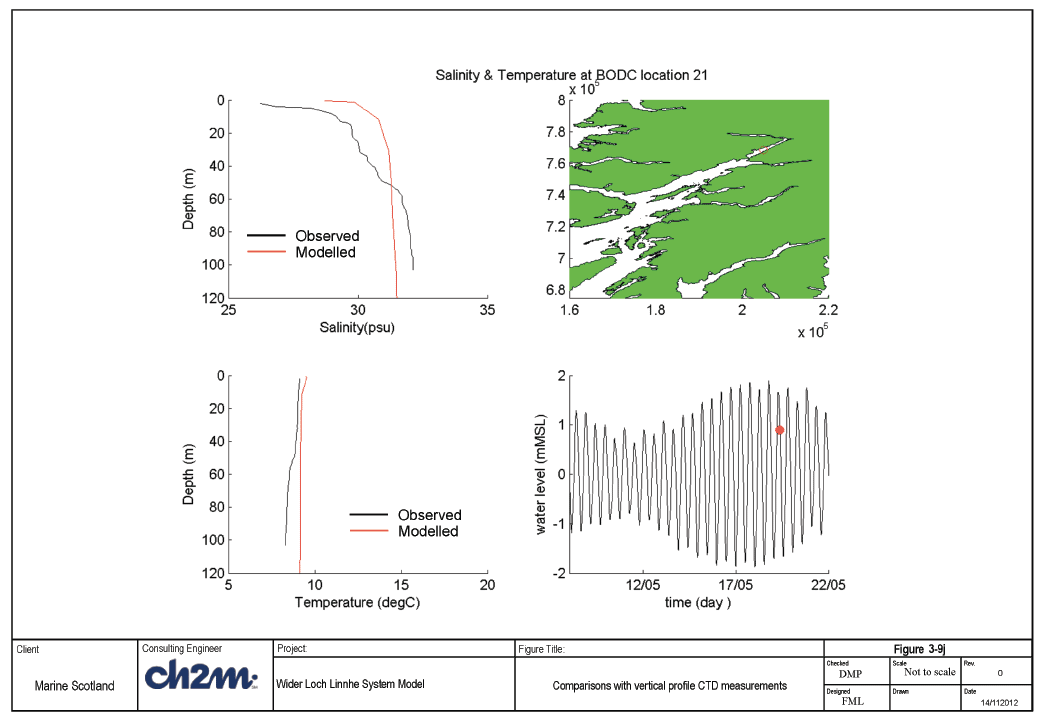
3.6 Flow Model Validation
Following on from the model calibration, it is good practice to validate the model against a different period of data, using the same model parameters and setup as used for the calibration simulation. For this purpose, we selected data from the October 2011 survey, combined with additional tide gauge and current data obtained from other surveys.
Boundary conditions were taken from the AMM results. As with the calibration run the model was run from a cold with constant temperature and salinity to ramp up the hydrodynamic before adding the temperature and salinity initial conditions from the Scottish Shelf model climatology run for the corresponding time step.
Figures 3-10a-e present the comparisons between observed water levels and those predicted by the model. The RMS errors and bias for three of the locations are as follows:-
Tobermory
RMS error = 0.27m
Bias error = -0.17m
Corpach
RMS error = 0.27m
Bias error = 0.12m
Fort William
RMS error = 0.24m
Bias error = 0.10m
These are very similar in magnitude to those calculated for the calibration simulation for May 2011 giving a percentage relative to the tidal range at these locations of approximately 6-14% which is within the limits set within our proposal and used for the other case study models.
Figure 3-11 shows the location of the data buoy within ULL and the comparison between the model (red) and data (black). Both the salinity and the temperature comparison seems to replicate the general pattern seen in the observations. However, for both parameters the impact of the river flow is less pronounced in the model compared to the measurements. One possibility is that the river discharge spreads over a thin surface layer, which is not well reproduced in the model. However the vertical profile plots appear to show overall fair agreement with data.
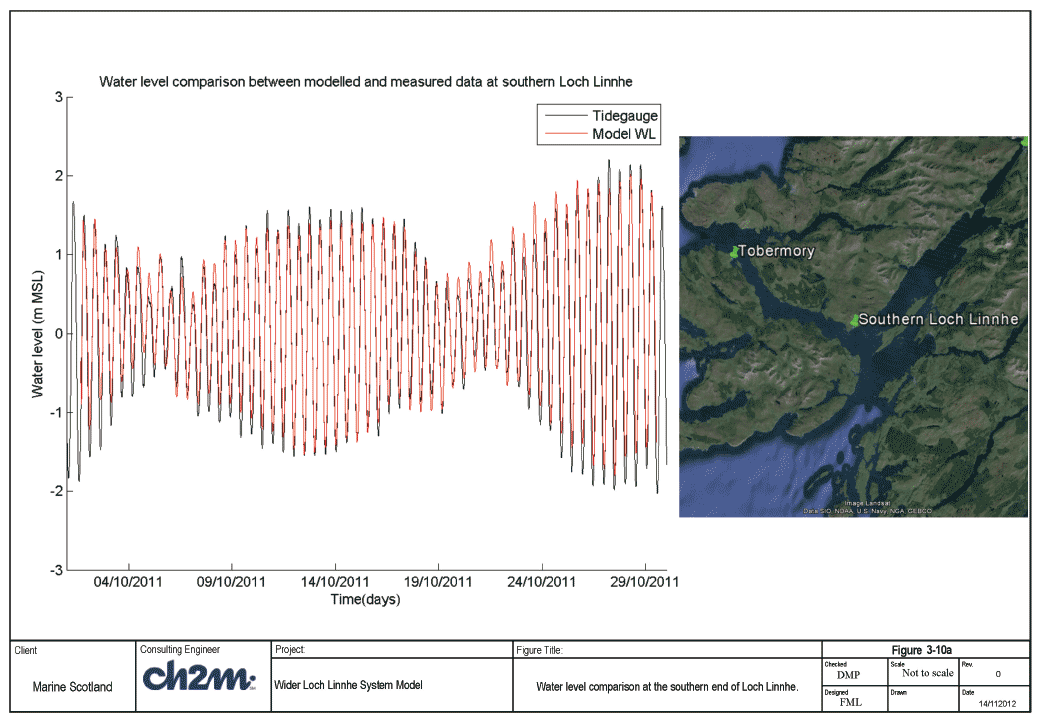
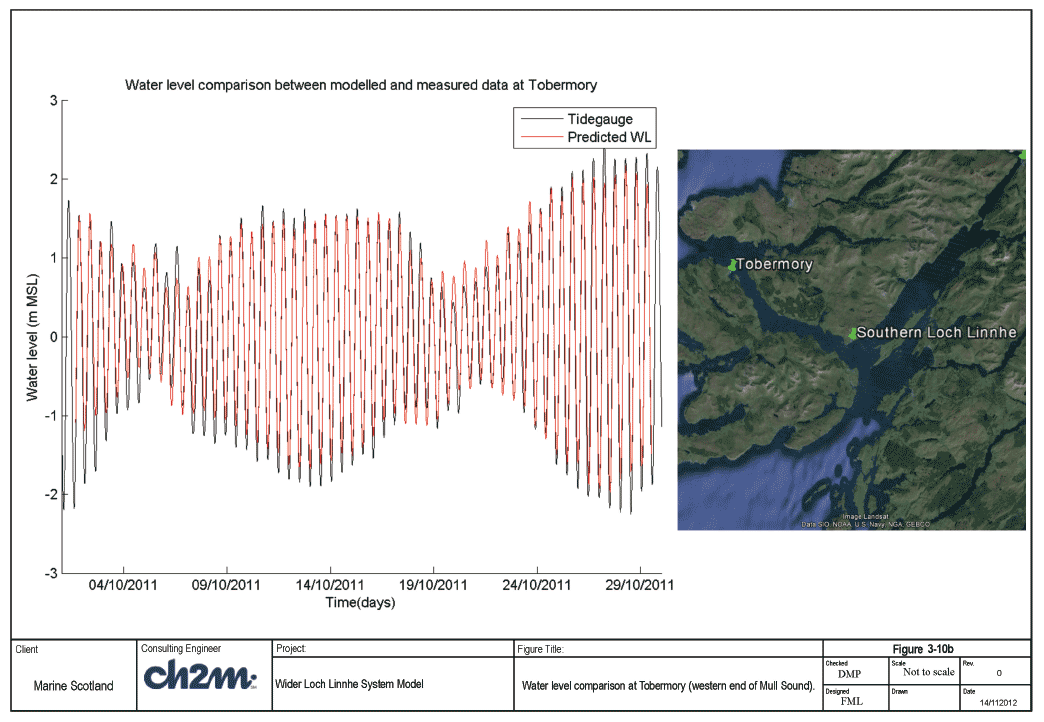
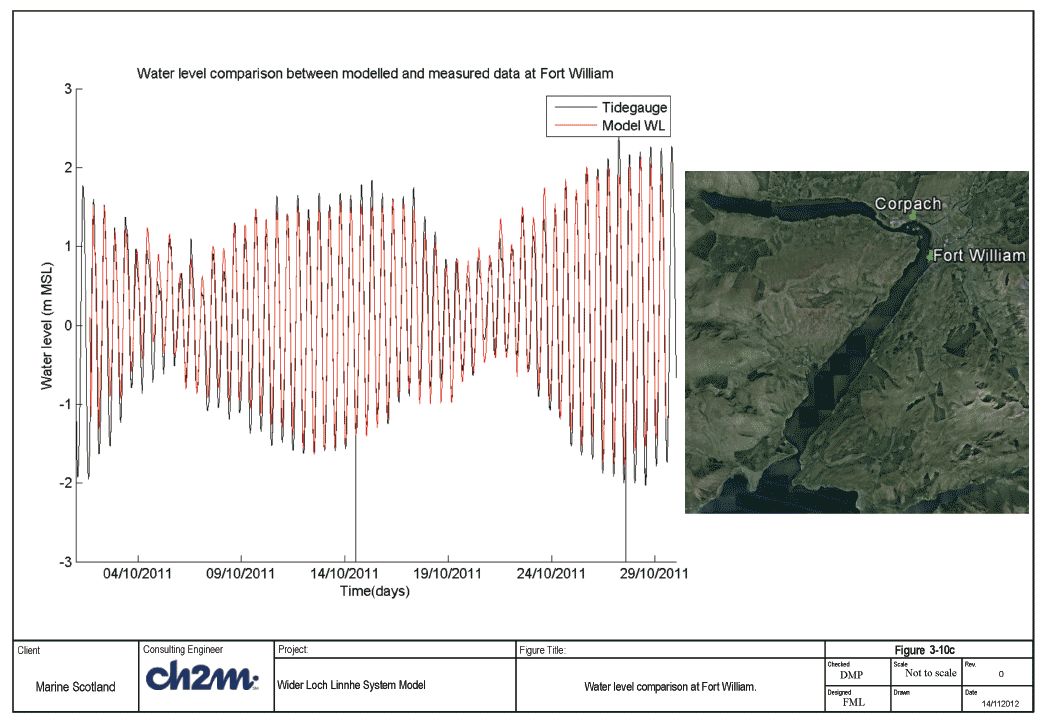
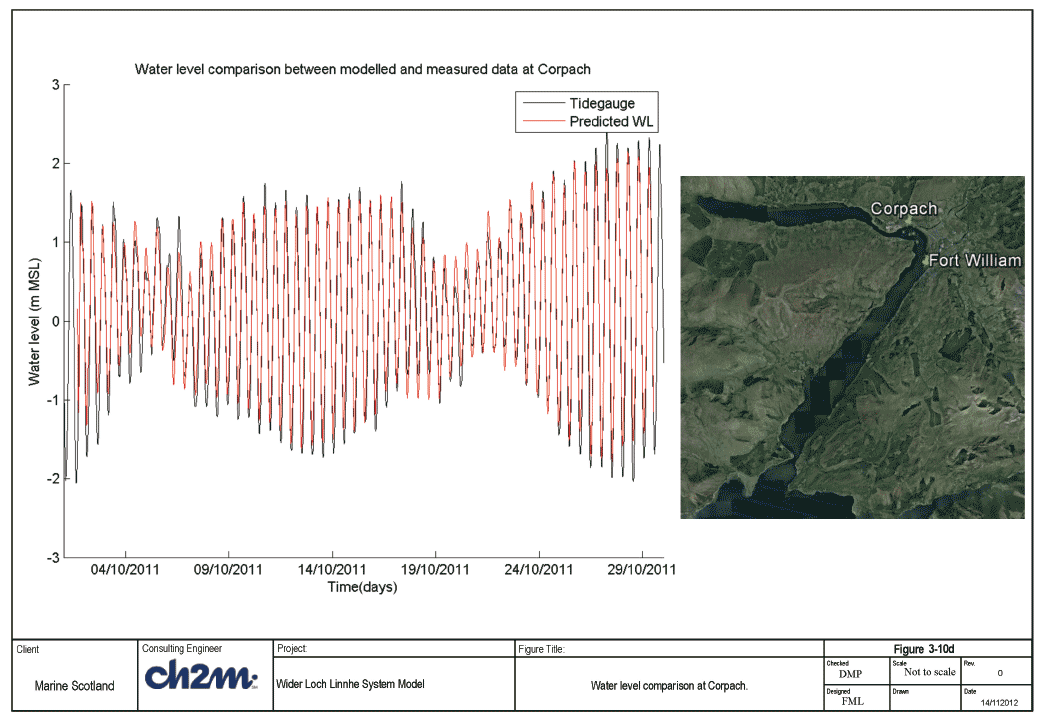
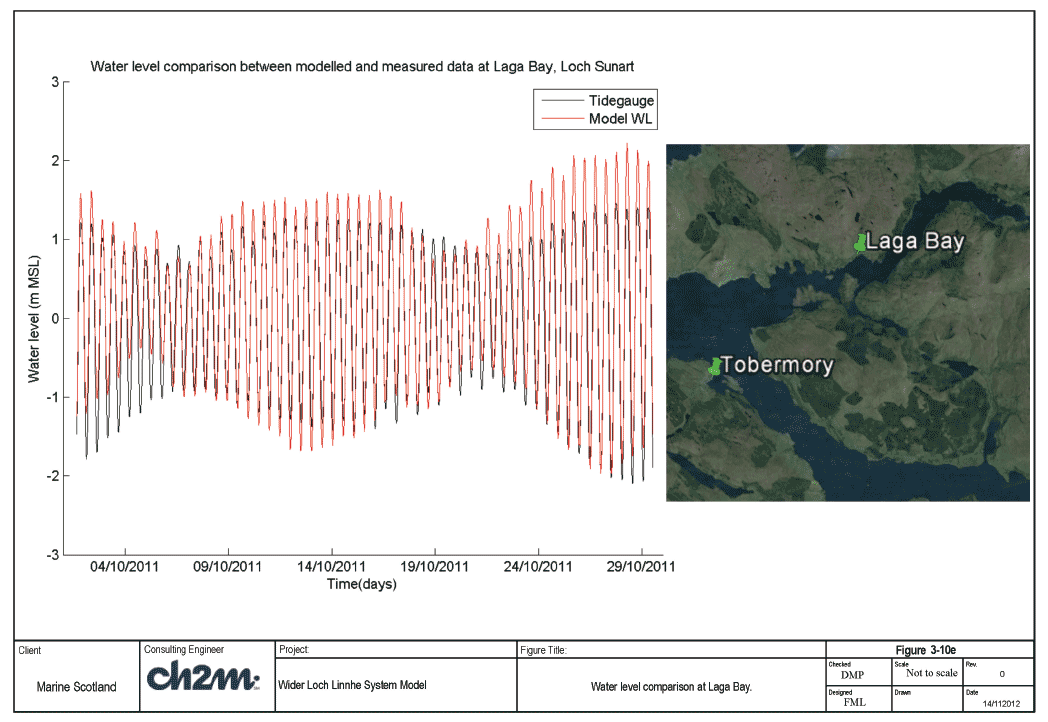
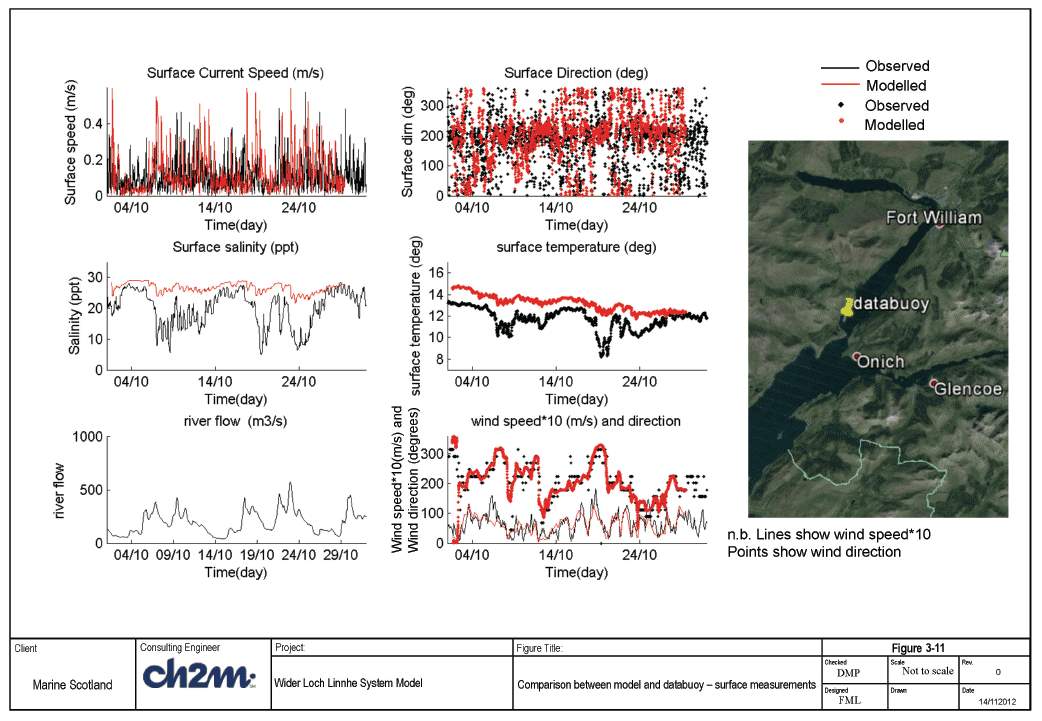
Three drogues were tracked as part of the survey. The comparisons with the model can be seen in Figures 3-12a-c. The first two Comparisons show poor reproduction of the drogue track in terms of the length of movement and time to the turn, whereas the third comparison is better with the drogue travelling further than the previous two but still fails to turn at the correct time.
Figures 3-13a-j present comparisons between observed CTD profiles and modelled profiles of temperature and salinity. The modelled temperature shows good agreement with the measured and picks up the stratification in the water column well at a number of locations (Figure 3-13d-f). The salinity profiles also show good agreement. The stratification in the salinity is also reproduced well by the model outside of ULL. In ULL the model under predicts the salinity levels by around 2psu below the surface but over predicts it at the surface indicating that the ULL in the model is more mixed in the vertical than the observations suggest. This may be related to the high river flows into ULL during October.
A short survey was undertaken by MS in June 2013 in the entrance to Loch Sunart. The ADCP data at a fixed station recorded current speeds and directions throughout the water column. This data was depth-averaged and a harmonic analysis carried out so that the tidal component of the flows could be plotted. The depth-averaged current speeds from the model at the same location were also harmonically analysed and repredicted for the same period as the data. The comparisons can be seen in Figures 3-14 a-c, these show the same data but at three different timescales so that the overall comparisons can be made along with more detailed ones.
Differences in speed are generally less than 0.05m/s, with the model being able to reproduce the general change in current speed throughout the tidal and spring-neap cycle. Although not an exact match, comparisons with directions are also good.
In addition to the fixed station, four transects were also undertaken within the Mull sound and the entrance to Loch Sunart. These were traversed at regular intervals throughout a tide. The results from the model have been compared with the recorded transect data by first undertaking a harmonic analysis on the current speed components for both the data and model results. The speeds/directions were then re-predicted and compared in Figures 3-15 a-h. In general the features and magnitude of the flow is reproduced by the model which gives confidence in its use within the Wider Loch Linnhe System outside of Loch Linnhe.
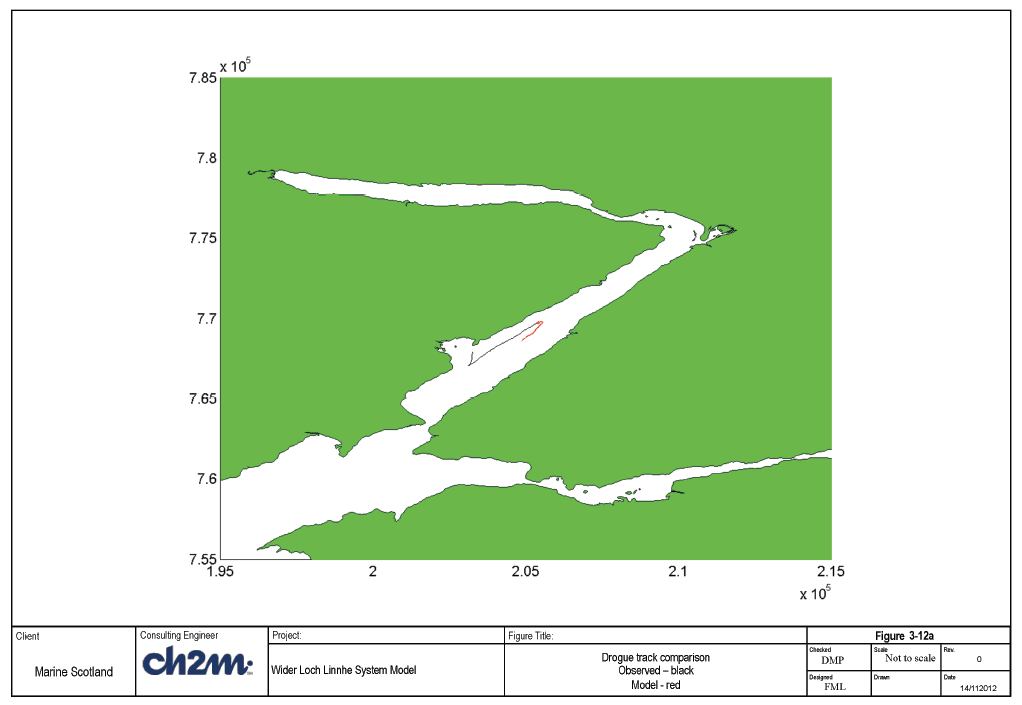
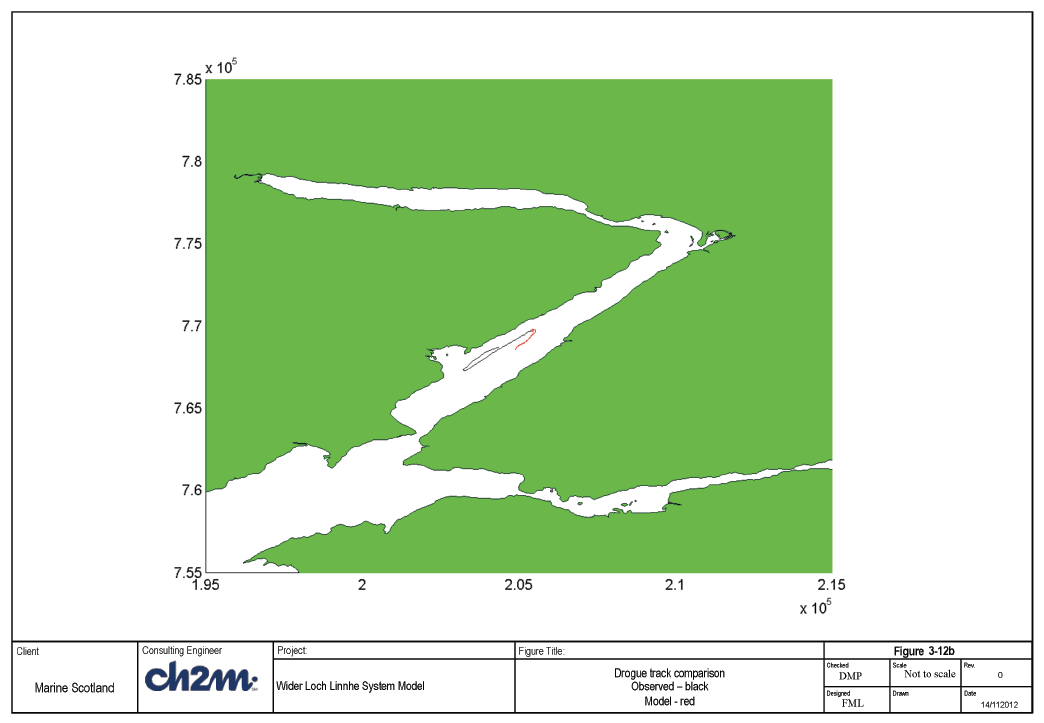
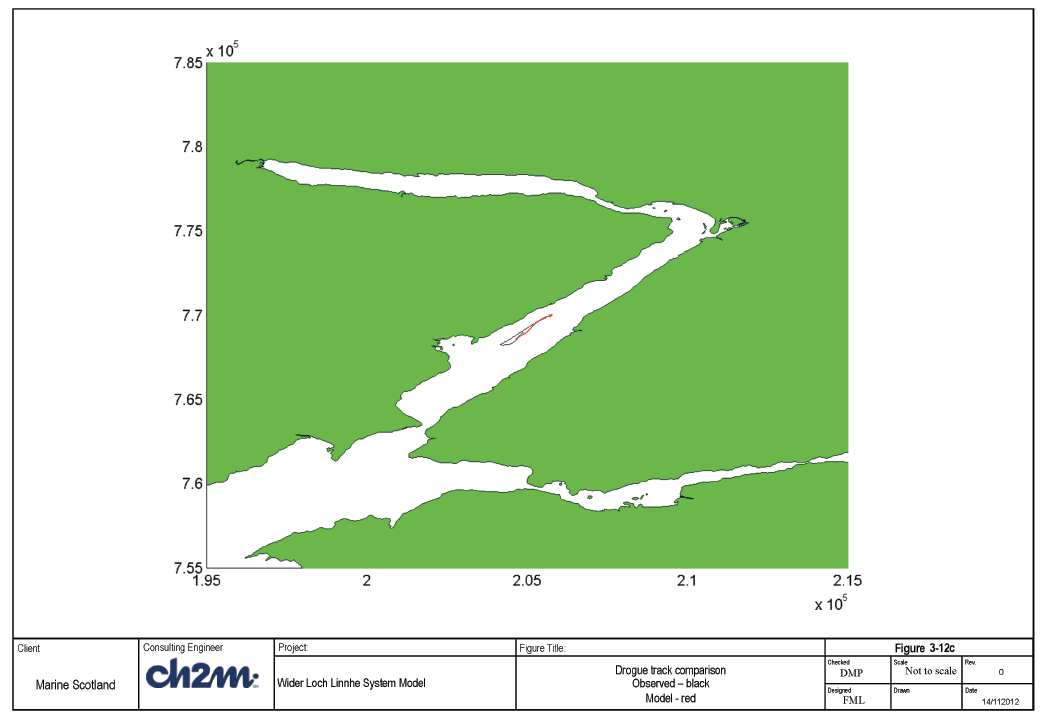
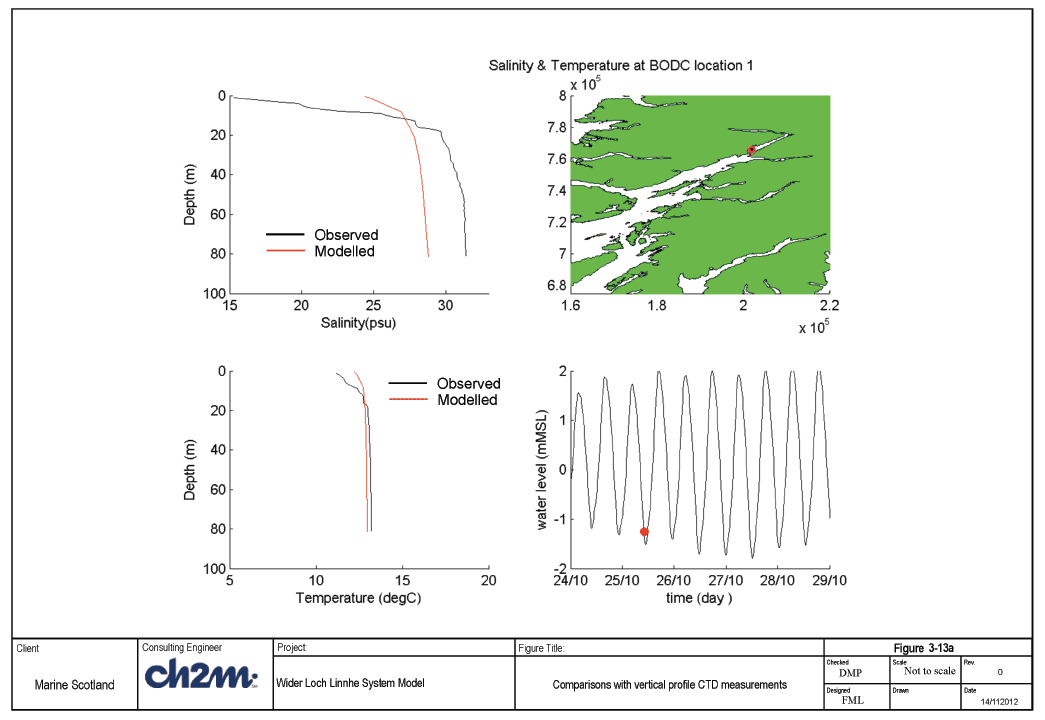
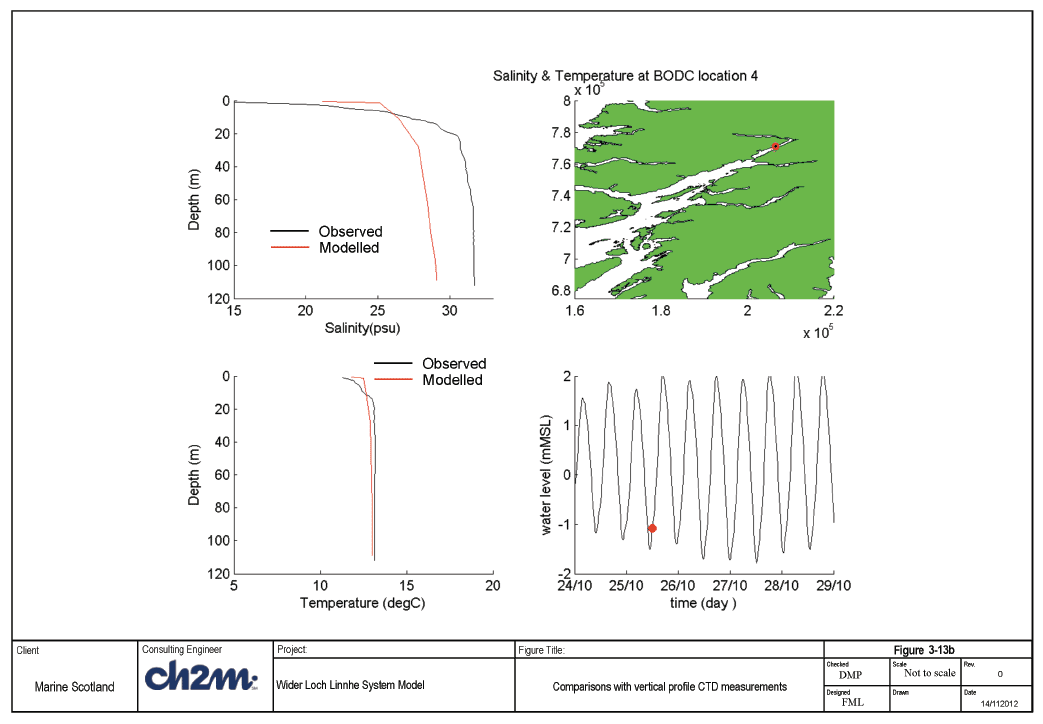
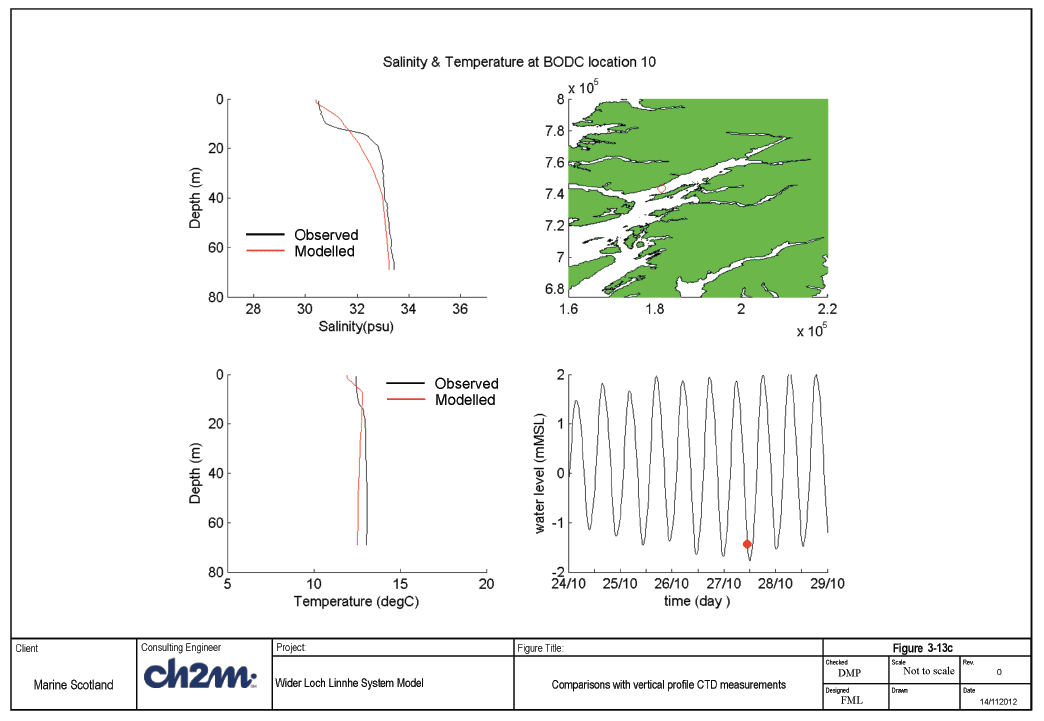
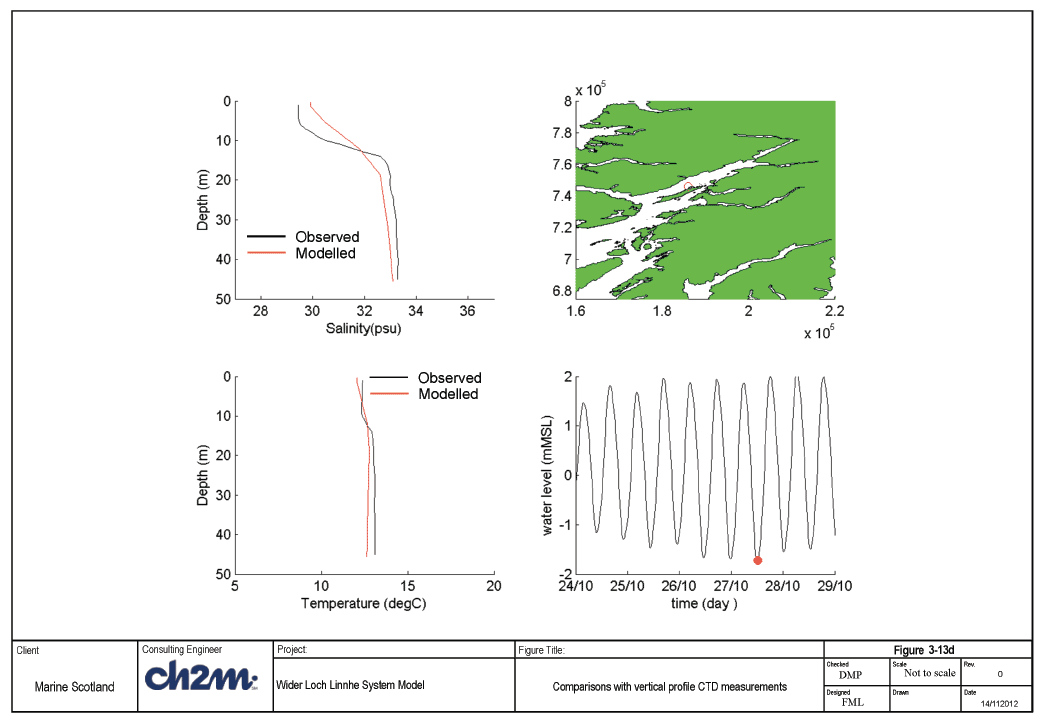
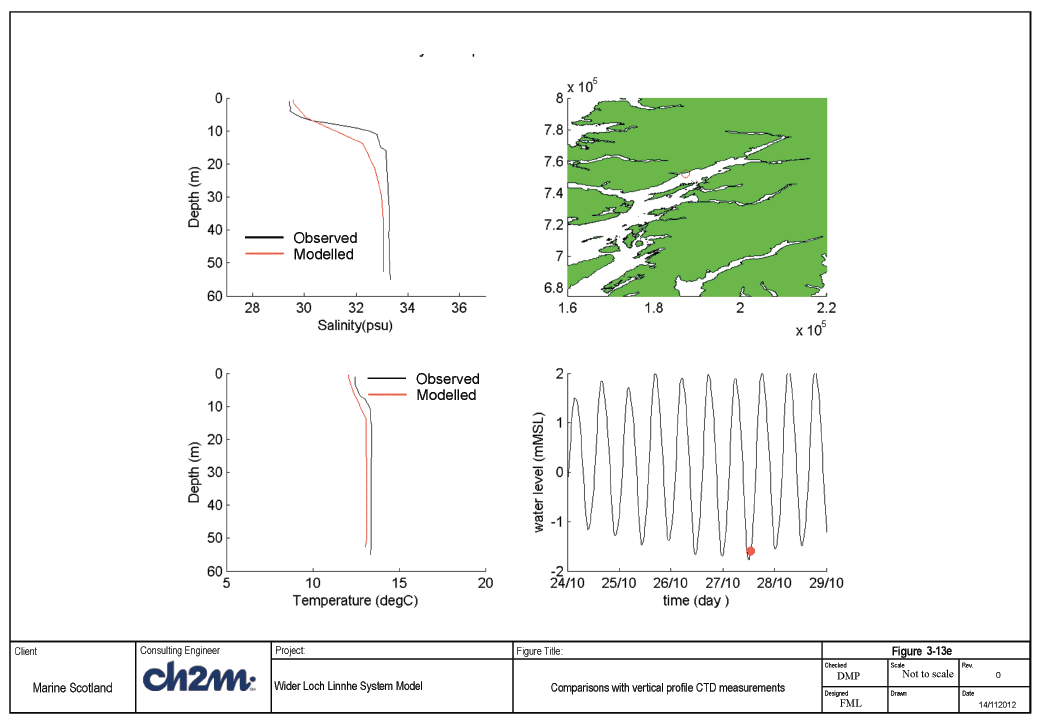
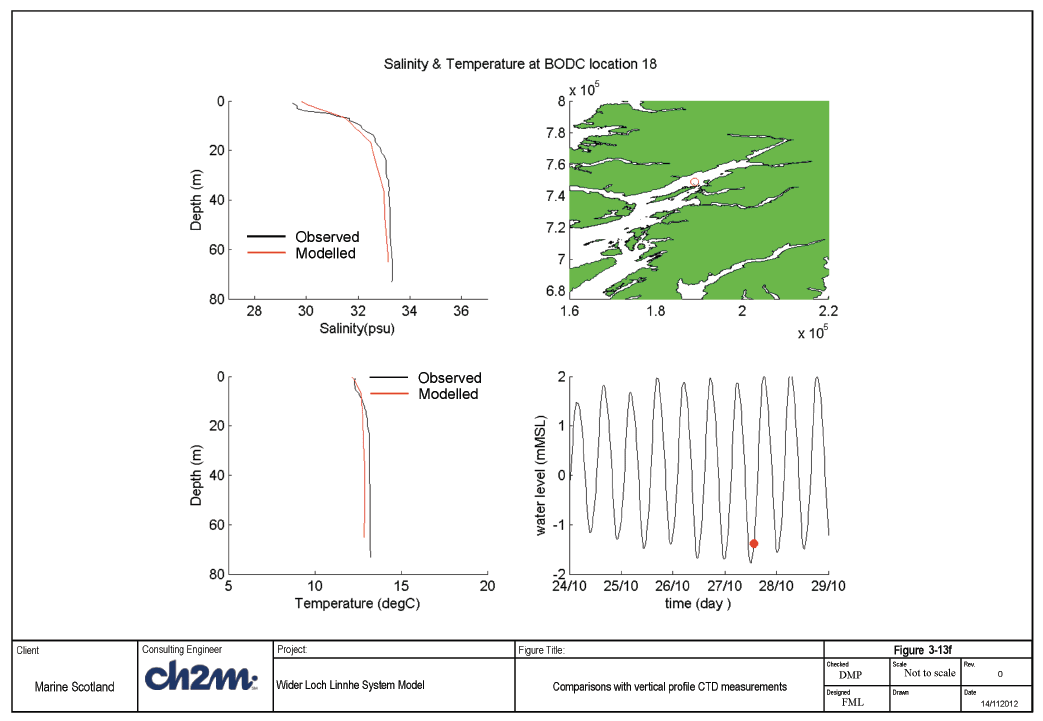
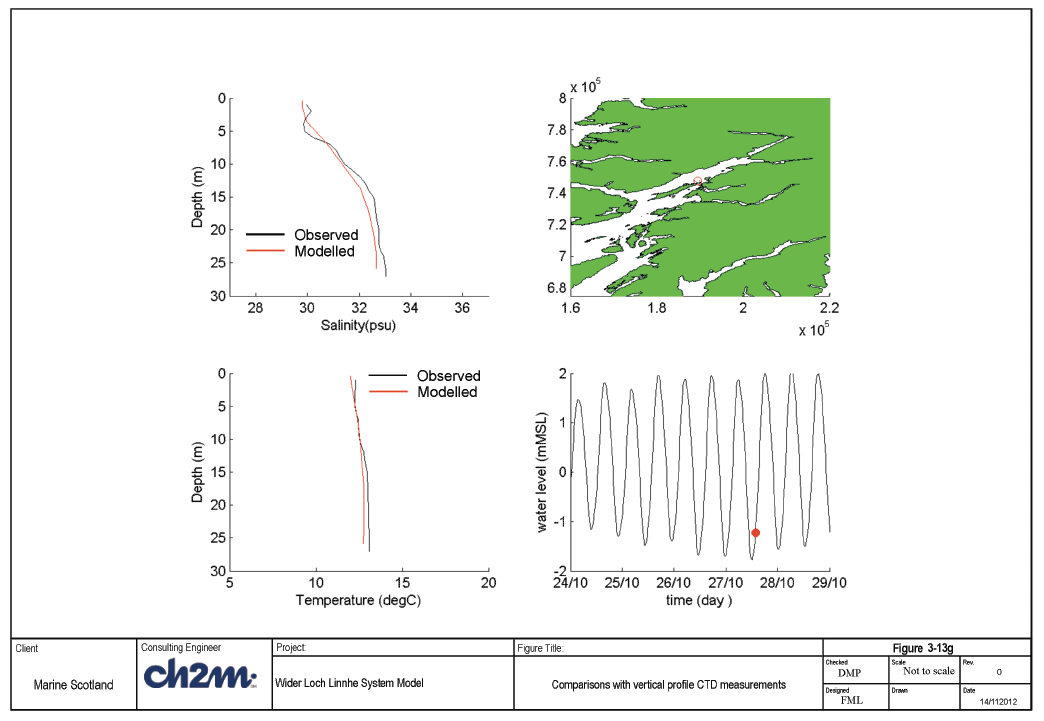
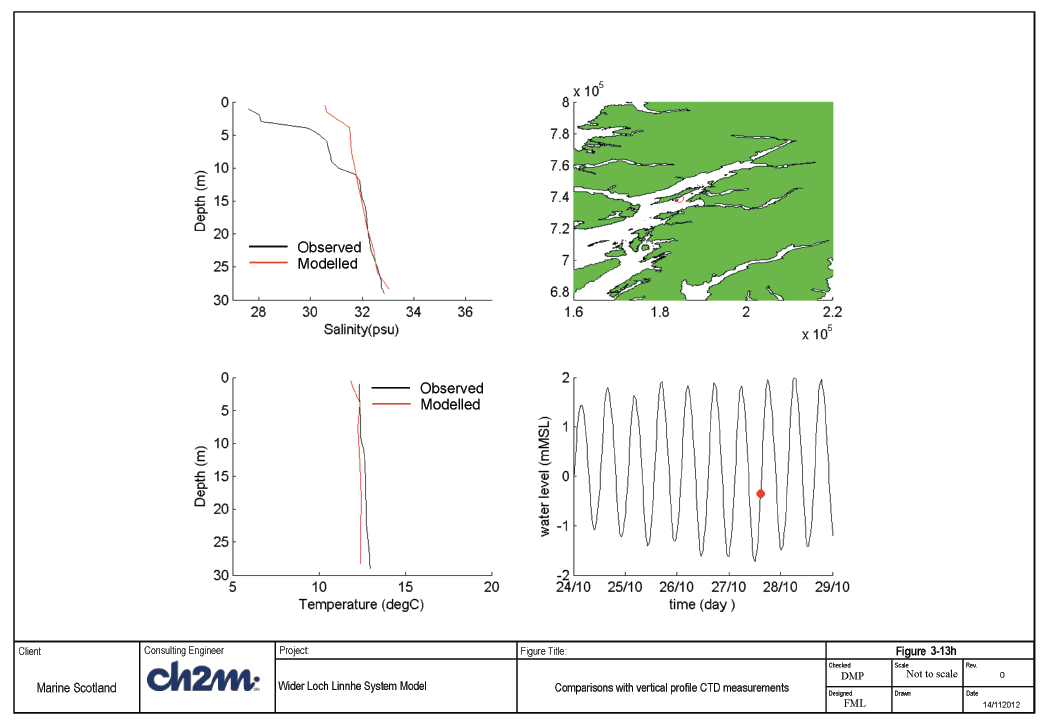
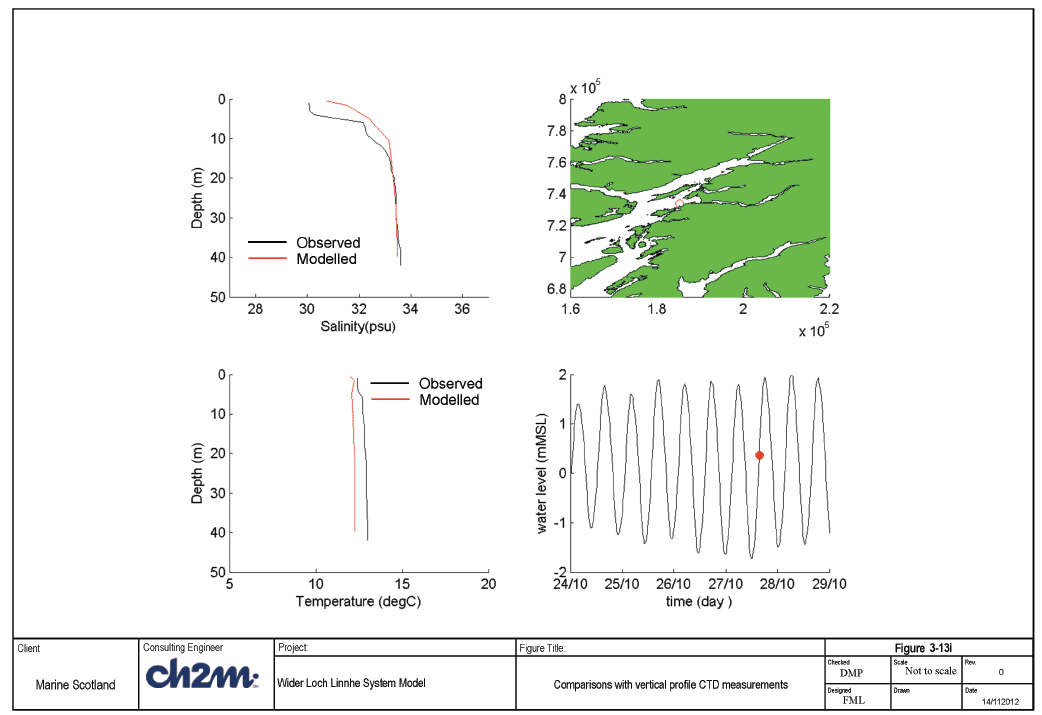
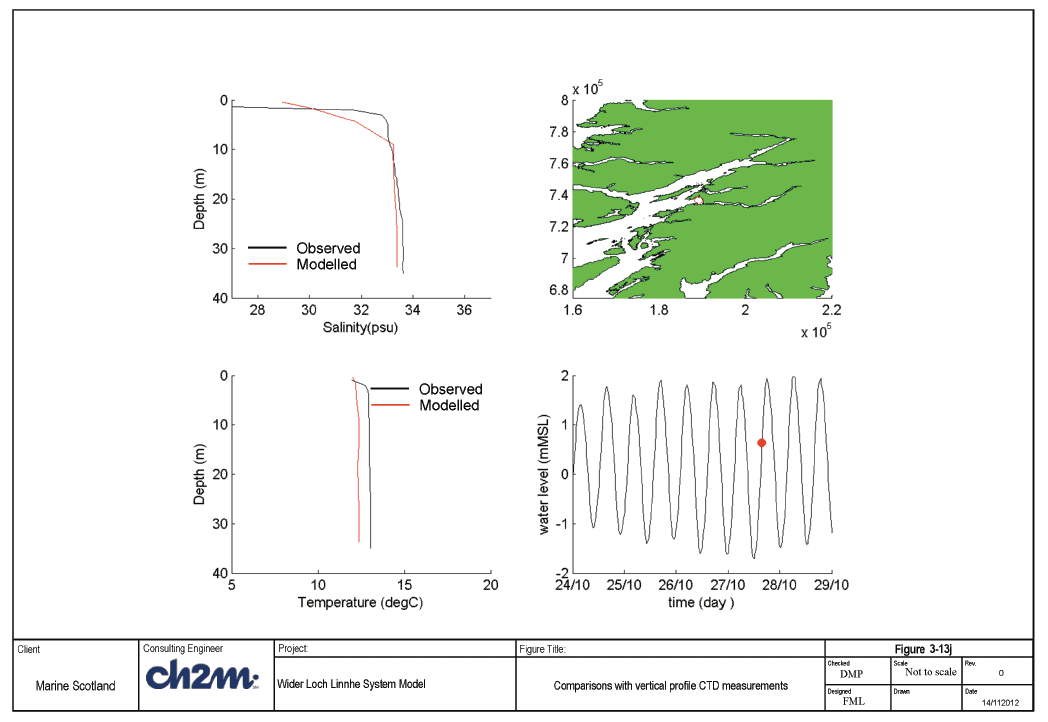
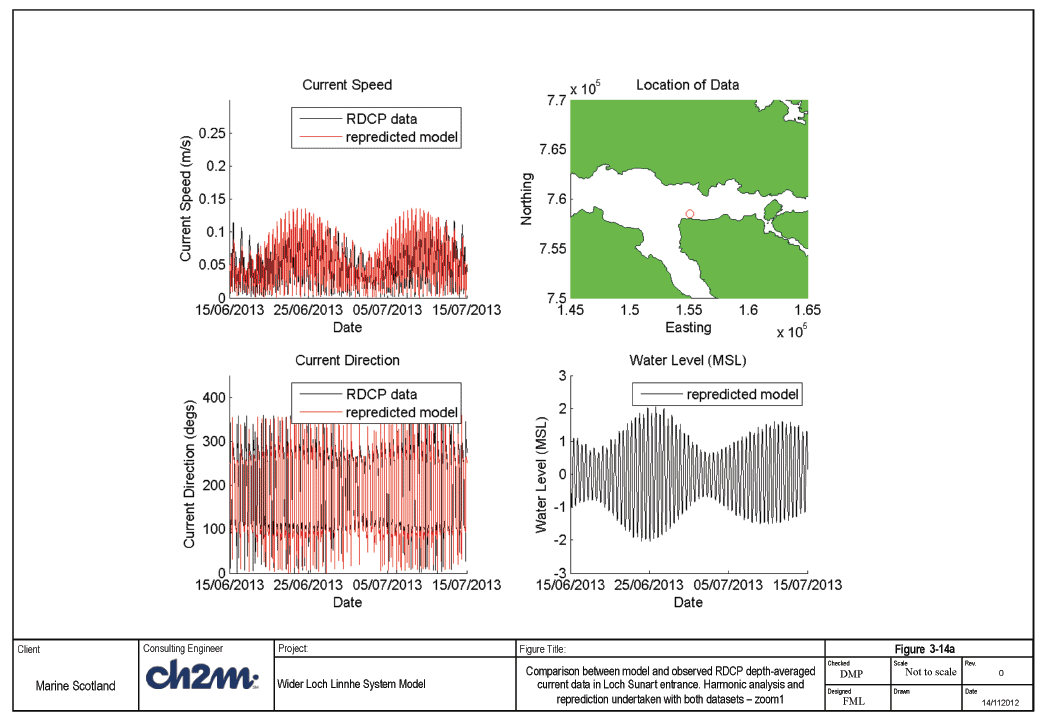
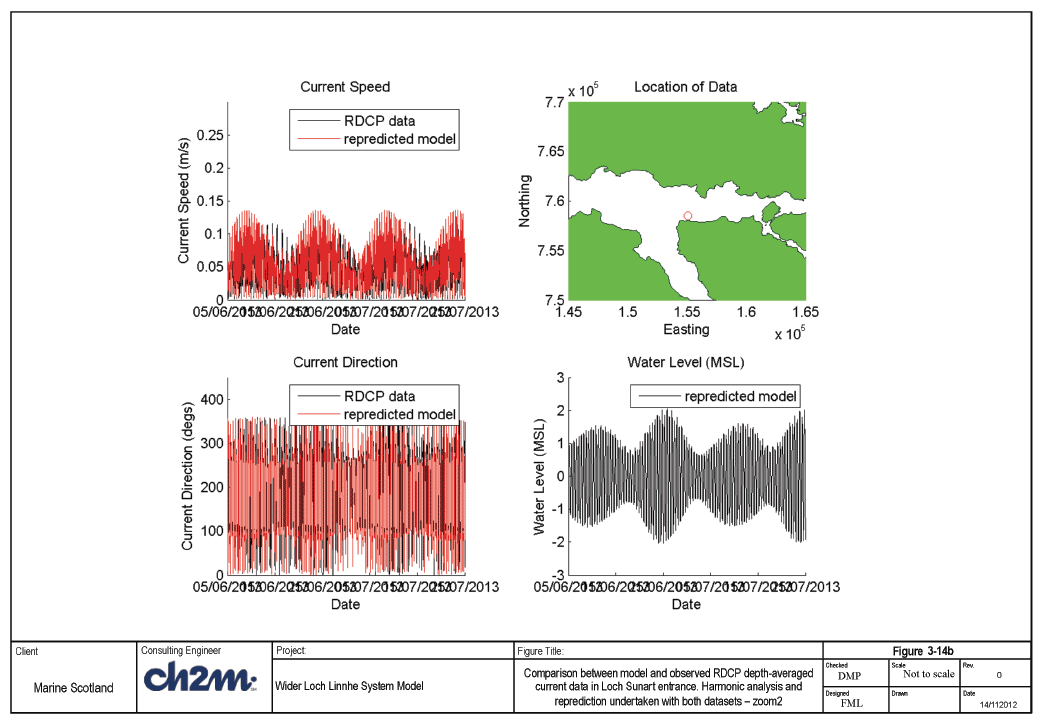
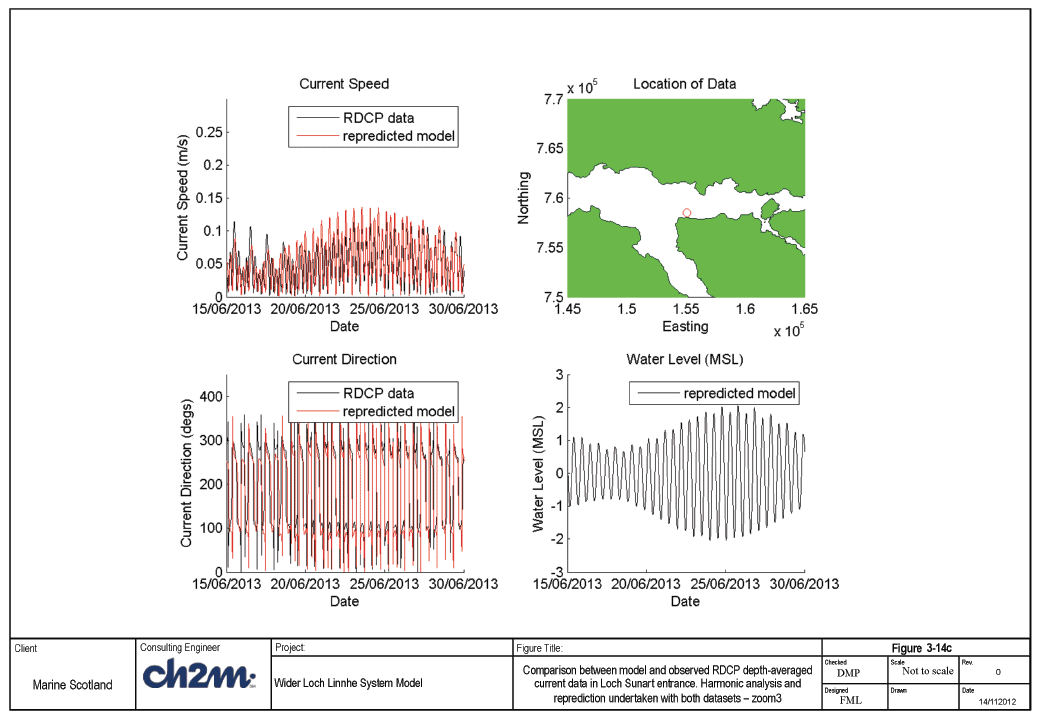
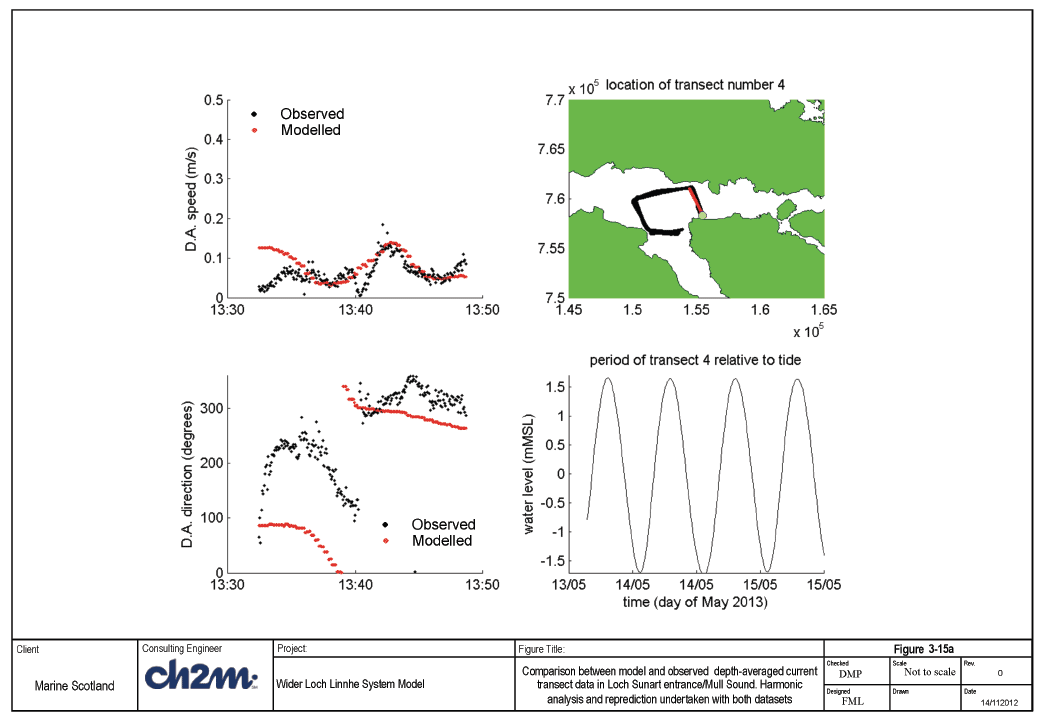
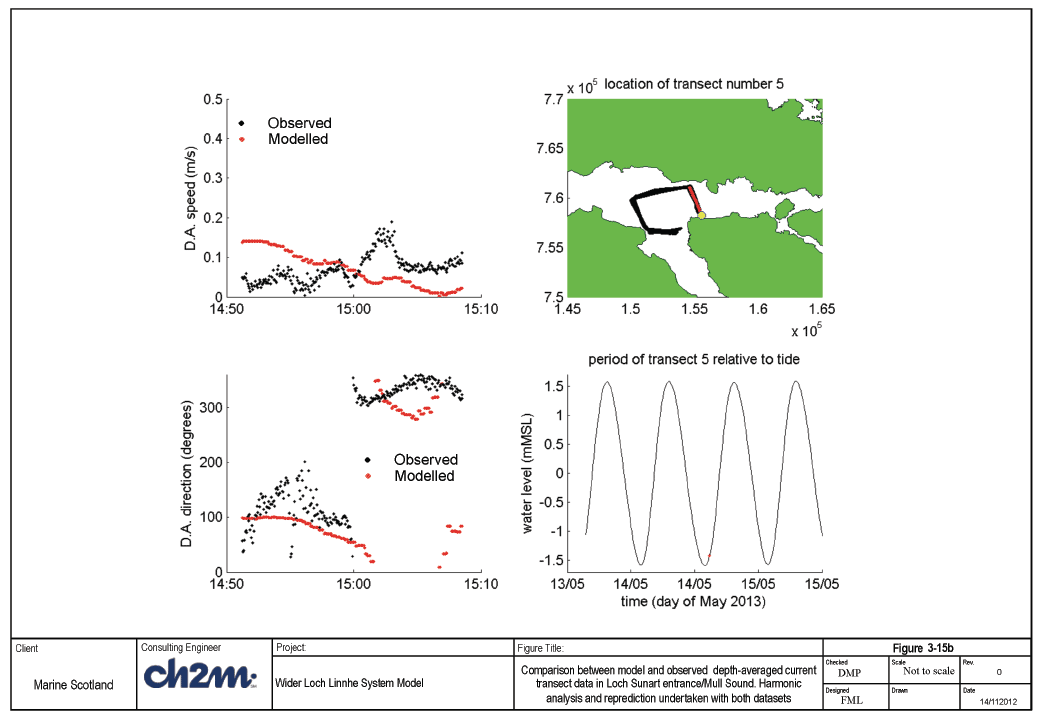
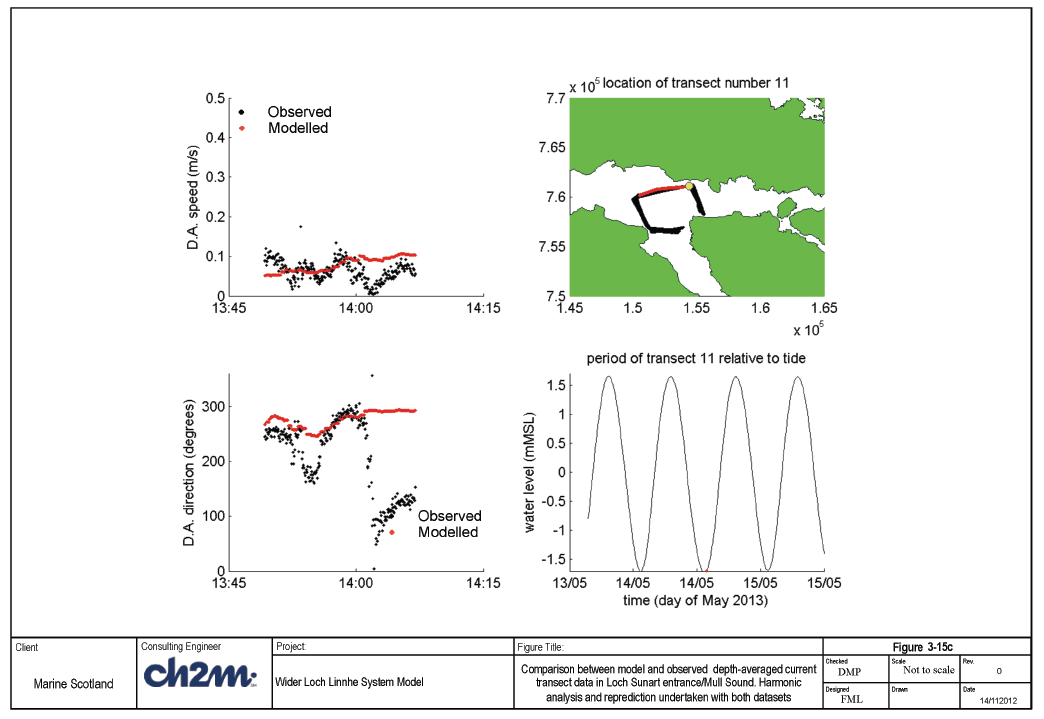
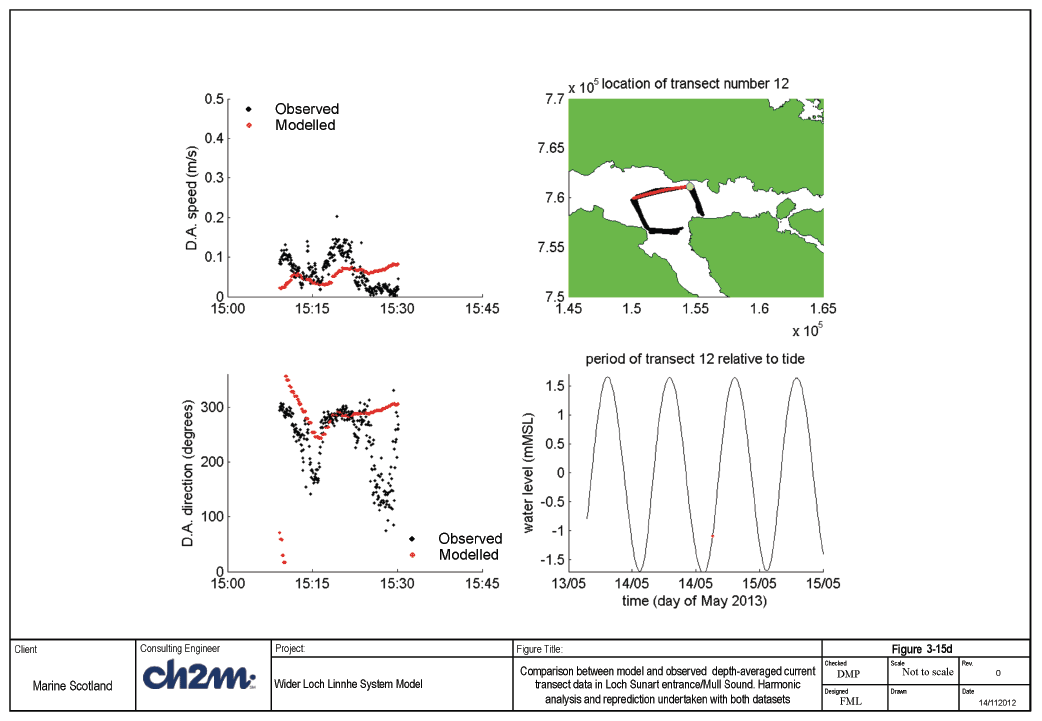
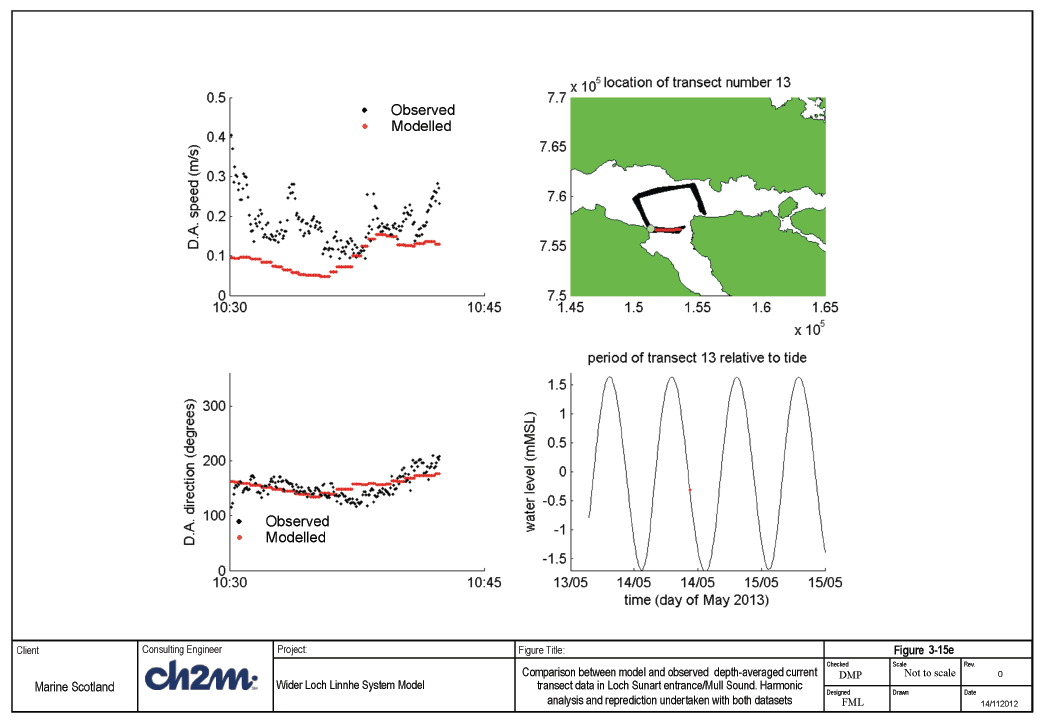
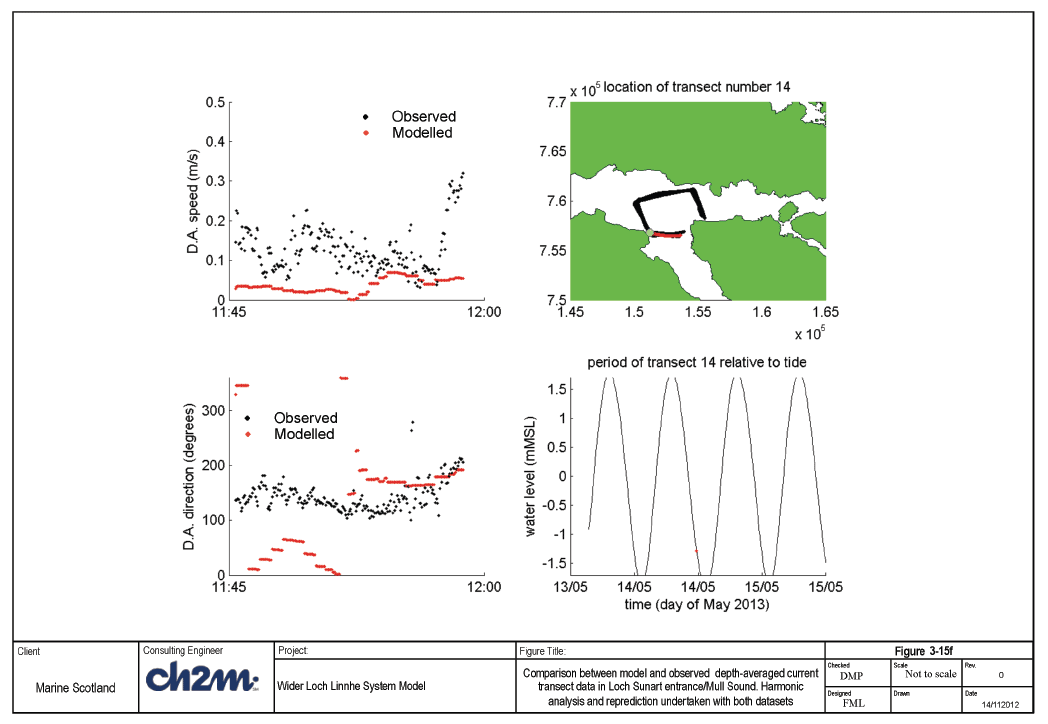
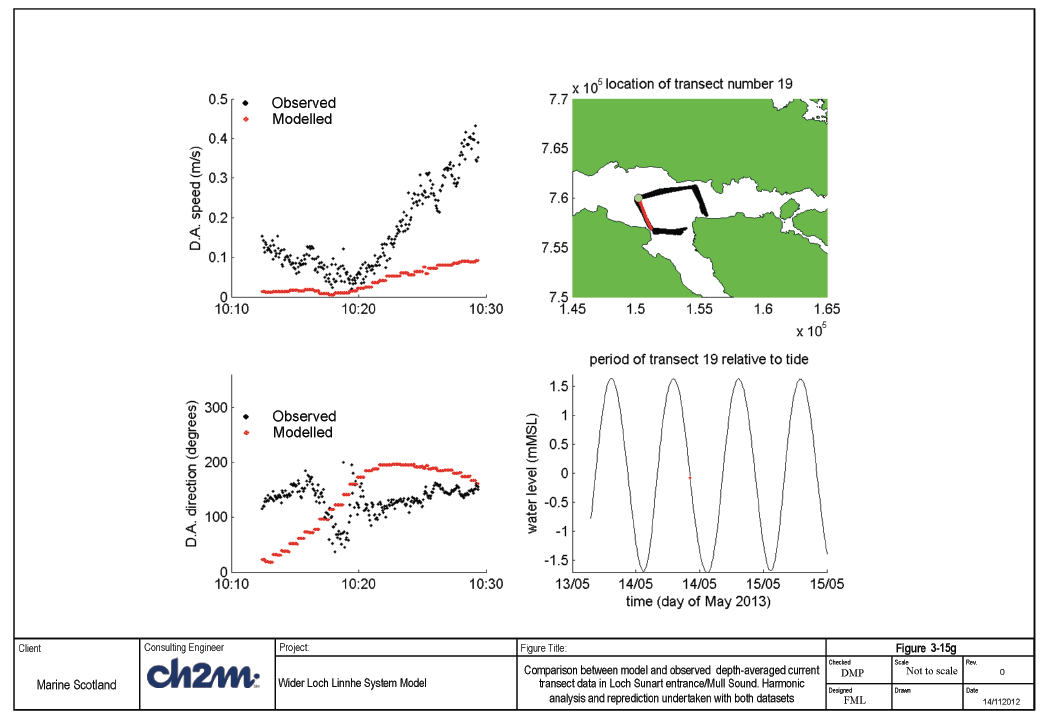
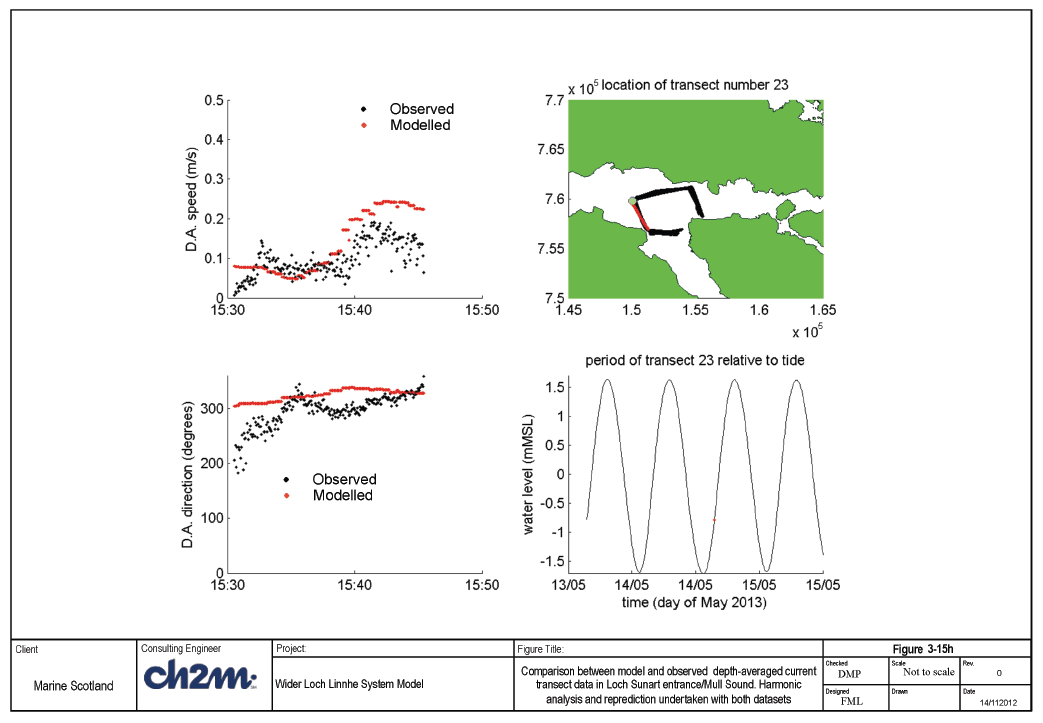
3.7 Summary for model calibration and validation
The WLLS model has been setup for the purposes of simulating the tidal and meteorological forced flows within the wider Loch Linnhe System, encompassing Loch Linnhe, Loch Sunart, Mull Sound and all side lochs within. Vertical resolution varied in order to try and capture the near surface freshwater plume during high fluvial events, especially in Upper Loch Linnhe. This was partially successful, although it is believed that to capture this correctly would require higher resolution in the near surface layers.
Water levels predicted by the model are in general good within the WLLS area. Similarly temperature and salinity are reproduced well, especially for the May 2011 calibration period. Current speeds are also reproduced well in terms of magnitude at the two sites within Loch Linnhe, although timing of the peaks is not always good; both sites are located in circulations which make this more difficult to achieve.
Comparisons with currents and direction in Mull Sound and Loch Sunart entrance are good with speeds of a similar order of magnitude, with the majority of the transect comparisons showing similar features in the model as was measured. It is concluded that this model has achieved a suitable level of calibration and validation.
Contact
There is a problem
Thanks for your feedback